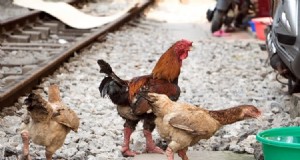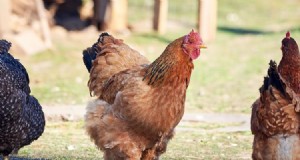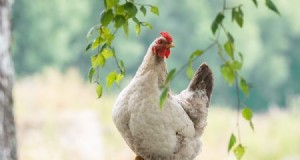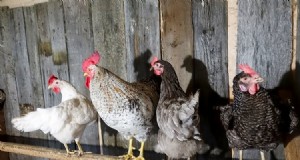A continuación, hemos reunido una lista de más de 100 razas de pollos.
Para cada raza, describimos su temperamento y capacidad de puesta de huevos para que pueda encontrar su gallina perfecta.
Incluso hemos creado una herramienta para ayudarte a encontrar tu pollo perfecto.
Ya sea que esté buscando una excelente ponedora de huevos, un impresionante ave de exhibición o una mascota, este artículo debería tener algo para usted.
Varias de nuestras selecciones están en peligro crítico y necesitan ayuda para su conservación (tal vez encuentre algo que le gustaría ayudar a conservar).
Cualquiera que sea su motivación para leer esto, esperamos que lo encuentre útil e interesante...
Razas de gallinas
- Capas de huevo
- Huevos de Pascua
- Cometa Dorado
- Orpington
- Propósito doble
- Rojo Rhode Island
- Wyandotte
- Mascotas
- Bancos
En esta guía
- Encuentra tu raza perfecta
- A-Z de cada raza
- Herramienta de selección de raza
- Consejos para elegir la raza perfecta
- 1. Haz tu tarea
- 2. Comprender los compromisos de tiempo
- 3. Los precios pueden variar
- 4. Trae ayuda
- 5. Revise sus estatutos
Encuentre su raza: 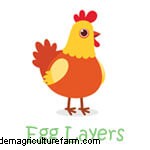
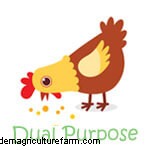
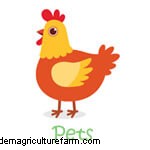
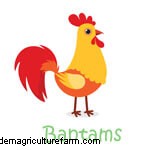
Capas de huevos
Ameraucana
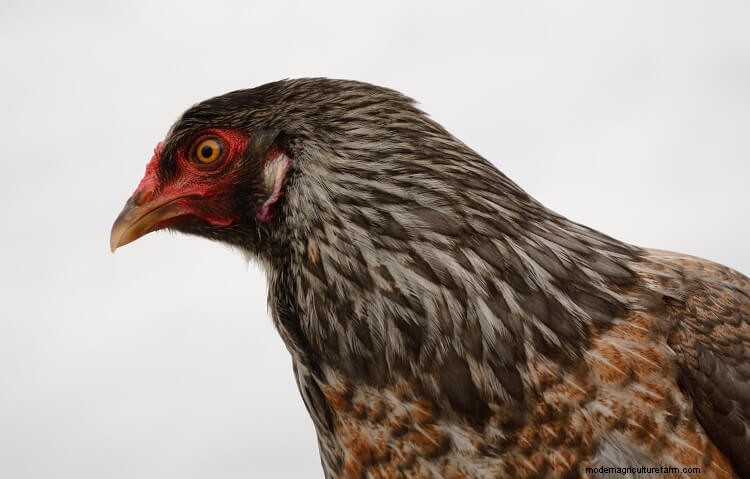
Las ameraucanas provienen de la araucana y son deliciosas a la vista.
Su plumaje es multicolor y también tienen barbas y manguitos que les dan una apariencia inusualmente esponjosa.
Las gallinas adultas pesan alrededor de 5 libras más o menos, pero si las quieres más pequeñas, también vienen en tamaño gallo. Su principal motivo de fama es poner huevos azules . Son ponedoras decentes que producen de 3 a 4 huevos por semana.
En cuanto a su personalidad, son amigables, inteligentes, curiosos y se llevan bien con los niños.
Son lo suficientemente silenciosos como para mantenerlos en un entorno urbano también.
| Ameraucana |
|---|
| Uso principal: Huevos |
| Producción anual de huevos: 175-250 |
| Color del huevo: Azul |
| Apto para principiantes: Sí |
| Temperamento: amistoso |
| Nivel de ruido: normales |
| Clima preferido: Cualquier |
Ancona
Esta raza se originó en Italia y tiene la forma clásica de una raza mediterránea.
Posee un hermoso plumaje moteado blanco y negro que mejora con la edad.
Son gallinas resistentes que pueden poner durante todo el invierno produciendo de 4 a 5 huevos grandes y blancos a la semana.
Con esta raza se puede esperar una gallina activa que no tolera bien el encierro. Son amigables con sus humanos y pueden ser muy habladores.
Son una ponedora de maduración temprana que tiene un buen índice de conversión alimenticia.
Los de tamaño estándar pesarán alrededor de 6 libras, pero también vienen en tamaño gallo.
| Ancona |
|---|
| Uso principal: Huevos |
| Producción anual de huevos: 175-250 |
| Color del huevo: Blanco |
| Apto para principiantes: Sí |
| Temperamento: asustadizo |
| Nivel de ruido: normales |
| Clima preferido: Cualquier |
Andaluz
El andaluz es otra raza mediterránea.
Se desconocen sus orígenes exactos, sin embargo, sabemos que son bastante antiguos, ya que los romanos los conservaron.
Mejor descritos como dignos y serenos, también son amigables y curiosos . Prosperan al aire libre, ya que el confinamiento cerrado los vuelve volubles, nerviosos y neuróticos.
Lo más común es encontrar esta raza en azul. De hecho mucha gente se queda con los andaluces por su gen azul dominante incompleto y lo usa para recargar las plumas azules en otras razas. Una vez que haya crecido por completo, pesará alrededor de 5 libras (hay variedades gallo disponibles).
Las gallinas son una ponedora moderadamente buena de huevos grandes y blancos (alrededor de tres huevos por semana).
| Andaluz |
|---|
| Uso principal: Huevos |
| Producción anual de huevos: 100-170 |
| Color del huevo: Blanco |
| Apto para principiantes: No |
| Temperamento: amistoso |
| Nivel de ruido: Fuerte |
| Clima preferido: Climas Cálidos |
Appenzeller
Conoce al Appenzeller Spitzhauben.
Ella es el ave nacional de Suiza y, como puedes adivinar, ¡son muy resistentes al frío!
El Appenzeller es un pollo pequeño y activo que es un excelente forrajeador.
Estas gallinas tienen una personalidad muy independiente y son inteligentes y siempre alertas. Pueden ser muy ruidosos, por lo que la vida urbana no les conviene.
Las variedades de color plata, oro y gamuza son las más populares, sin embargo, esta gallina sigue siendo rara en los EE. UU.
Espere que pongan alrededor de tres huevos blancos medianos a la semana.
| Appenzeller |
|---|
| Uso principal: Huevos |
| Producción anual de huevos: 100-170 |
| Color del huevo: Blanco |
| Apto para principiantes: No |
| Temperamento: amistoso |
| Nivel de ruido: Fuerte |
| Clima preferido: Cualquier |
Araucana

Originaria de Chile, esta raza se encontró viviendo entre los indios mapuche.
Se cree que es una mezcla de dos razas más antiguas (Collonca y Quetros).
La Araucana definitivamente tiene un aspecto diferente. No tiene grupa y tiene extraños mechones que sobresalen de sus orejas. Estos mechones se ven un poco caprichosos, pero el gen que los hace puede ser mortal para los polluelos. Alrededor del 25 % de todos los polluelos de araucana morirán en el cascarón debido al gen del empenachamiento.
Las araucanas se describen mejor como amistosas, tranquilas y buenas con los niños. Prefieren estar activos pero tolerarán el encierro.
Son ponedoras decentes de tres huevos de color azul claro de tamaño mediano cada semana.
Ella es la original ponedora de huevos azules.
Las gallinas tienden a ponerse melancólicas y son buenas madres.
Son un pájaro pequeño que pesa alrededor de 4-5 libras para la gallina estándar. Si bien existen gallos, son difíciles de encontrar.
| Araucana |
|---|
| Uso principal: Huevos |
| Producción anual de huevos: 100-170 |
| Color del huevo: Azul |
| Apto para principiantes: Sí |
| Temperamento: amistoso |
| Nivel de ruido: Tranquilo |
| Clima preferido: Cualquier |
Blanco Austra
El Austra White es una superestrella que pone huevos.
Fue criada para la producción de huevos y pondrá más de 4 huevos grandes cada semana.
Sus padres son un gallo Australorp negro con una gallina Leghorn blanca.
El gen Australorp agrega algo de tamaño a la normalmente delgada Leghorn. Las gallinas pueden engordar muy bien hasta alrededor de 5 lb y los gallos hasta alrededor de 6 lb.
Se los describe como tranquilos, dóciles y amigables, por lo que se llevan bien con los niños y no se oponen a que los recojan.
Su plumaje es mayormente blanco con manchas negras ocasionales por todas partes.
| Blanco Austra |
|---|
| Uso principal: Huevos |
| Producción anual de huevos: 250+ |
| Color del huevo: Blanco |
| Apto para principiantes: Sí |
| Temperamento: Dócil |
| Nivel de ruido: normales |
| Clima preferido: Cualquier |
Australorp
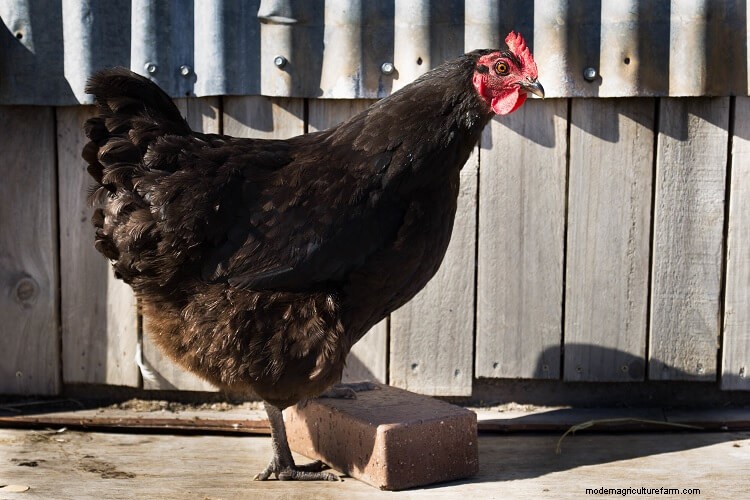
El Australorp se creó en Australia cruzando Orpingtons con Rhode Island Reds, Minorcas y algunas otras razas.
Esto creó una superestrella que pone huevos y Australorps es el ave nacional de Australia.
Las gallinas ponen de 4 a 5 huevos medianos de color marrón claro cada semana, con un promedio de alrededor de 250 huevos al año.
Aunque inicialmente serán tímidos, ella se volverá curiosa y le encantará investigar cosas.
Por lo general, su plumaje es negro, sin embargo, hay otras variedades disponibles.
Son un pollo de bajo mantenimiento que se lleva bien tanto con niños como con principiantes.
| Australorp |
|---|
| Uso principal: Huevos |
| Producción anual de huevos: 250+ |
| Color del huevo: Marrón |
| Apto para principiantes: Sí |
| Temperamento: amistoso |
| Nivel de ruido: normales |
| Clima preferido: Cualquier |
Marans de cobre negro
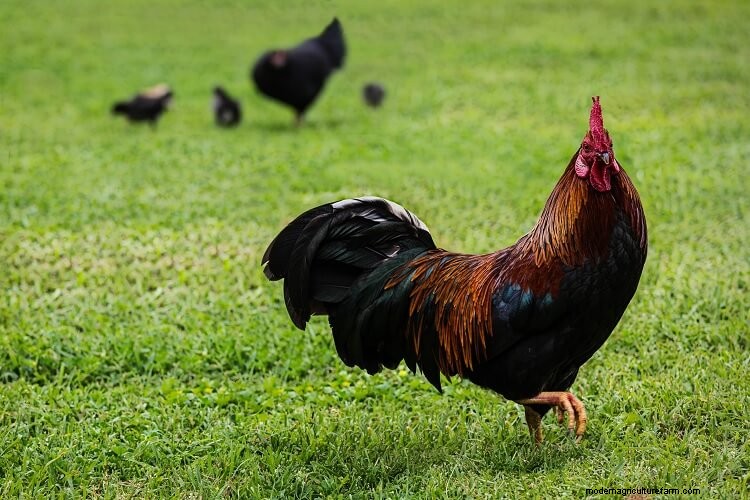
Black Copper Marans se ha vuelto enormemente popular debido a sus huevos de color chocolate oscuro.
A medida que continúa la temporada de puesta, el color de los huevos se volverá más claro; sin embargo, seguirá estando bastante oscuro.
Los Maran son una combinación de varias razas reunidas en el oeste de Francia a principios del siglo XX. Su plumaje es de un llamativo color negro (con iridiscencia verde) con el pelo cobrizo.
Se consideran una raza de doble propósito y pondrán alrededor de 3 huevos cada semana.
Es una gallina tranquila y mansa que generalmente es bastante fuerte y saludable. Hay tanto de tamaño estándar (gallinas de alrededor de 6,5 libras) como gallos. Sin embargo, los gallos son increíblemente raros y difíciles de encontrar.
| Marans de cobre negro |
|---|
| Uso principal: Huevos |
| Producción anual de huevos: 100-170 |
| Color del huevo: Chocolate |
| Apto para principiantes: Sí |
| Temperamento: Dócil |
| Nivel de ruido: Tranquilo |
| Clima preferido: Cualquier |
Enlace sexual negro
También conocido como Black Star, el pollo black sex link es uno de los pollos más populares.
Técnicamente no son una raza, sino un híbrido. Son un cruce entre un gallo Rhode Island Red o New Hampshire con una gallina Barred Rock. Cuando los polluelos nacen, los machos tienen un punto blanco en la cabeza (por lo que son muy fáciles de sexar).
Son populares porque son excelentes ponedoras de 5 huevos de color marrón claro cada semana.
Es una raza dócil, amigable y activa que se encariñará con sus cuidadores.
| Enlace sexual negro |
|---|
| Uso principal: Huevos |
| Producción anual de huevos: 250+ |
| Color del huevo: Marrón |
| Apto para principiantes: Sí |
| Temperamento: Dócil |
| Nivel de ruido: normales |
| Clima preferido: Cualquier |
Leghorn marrón
La Leghorn marrón es una de las variedades de Leghorn que crece bien en una granja.
Este es un pollo activo, independiente e inteligente que puede volar bien.
Son mejor conocidos como recolectores ingeniosos que son baratos de mantener.
Brown Leghorns le dará 3-4 huevos blancos grandes cada semana. No tienden a volverse melancólicas, pero son buenas madres.
Originarios de Italia, tienen la esbelta constitución mediterránea. Pueden tener una cresta simple o rosa y también pueden tener lóbulos blancos.
Lamentablemente, deben evitar la vida urbana, ya que pueden ser ruidosos.
| Livorno marrón |
|---|
| Uso principal: Huevos |
| Producción anual de huevos: 175-250 |
| Color del huevo: Blanco |
| Apto para principiantes: Sí |
| Temperamento: Audaz (seguro de sí mismo) |
| Nivel de ruido: Fuerte |
| Clima preferido: Climas Cálidos |
Campine
El Campine es una antigua raza noble de Bélgica.
Se cree que existió en la época romana, sin embargo, desde entonces su popularidad ha disminuido y ahora se considera en peligro crítico.
Es una gallina pequeña y solo pesa alrededor de 5 libras (también hay variedades gallo disponibles). Hay dos variedades:plata y oro.
Campines produce 3 huevos blancos grandes a la semana.
Se les conoce como una raza activa a la que le encanta buscar comida. Es curiosa, inteligente y amistosa hasta cierto punto, pero no le gusta que la carguen. Son tolerantes a una amplia variedad de climas, pero no les va bien en áreas muy frías.
| Campina |
|---|
| Uso principal: Huevos |
| Producción anual de huevos: 175-250 |
| Color del huevo: Blanco |
| Apto para principiantes: No |
| Temperamento: Audaz (seguro de sí mismo) |
| Nivel de ruido: normales |
| Clima preferido: Cualquier |
CherryEgger
A pesar del nombre, ¡Cherry Egger no pone huevos de color cereza!
El nombre hace referencia al color de su plumaje.
Son un híbrido en el que uno de los padres es Rhode Island Red y el otro New Hampshire Red.
Como era de esperar con padres tan prolíficos que ponen huevos, también son excelentes ponedoras y dan de 4 a 5 huevos por semana.
Es una raza amigable y dócil adecuada para un entorno urbano.
Están fácilmente disponibles en muchos criaderos.
| Cherry Egger |
|---|
| Uso principal: Huevos |
| Producción anual de huevos: 250+ |
| Color del huevo: Marrón |
| Apto para principiantes: Sí |
| Temperamento: amistoso |
| Nivel de ruido: normales |
| Clima preferido: Cualquier |
Reina Canela
Cinnamon Queen es otro nombre más para Red Sex Link Chickens.
Red Sex Links se llama así porque puedes notar la diferencia entre el macho y la hembra al nacer (¡así que no debería haber gallos accidentales)!
Son un pollo híbrido que se desempeña muy bien en la puesta de huevos. Ella debería poner alrededor de 5-6 huevos cada semana.
Puede esperar una raza amigable y dócil que sea fácil de manejar.
Se sabe que son tranquilos, por lo que un entorno urbano está bien para ellos.
| Reina de la Canela |
|---|
| Uso principal: Huevos |
| Producción anual de huevos: 250+ |
| Color del huevo: Marrón |
| Apto para principiantes: Sí |
| Temperamento: Dócil |
| Nivel de ruido: Tranquilo |
| Clima preferido: Cualquier |
Pierna Crema
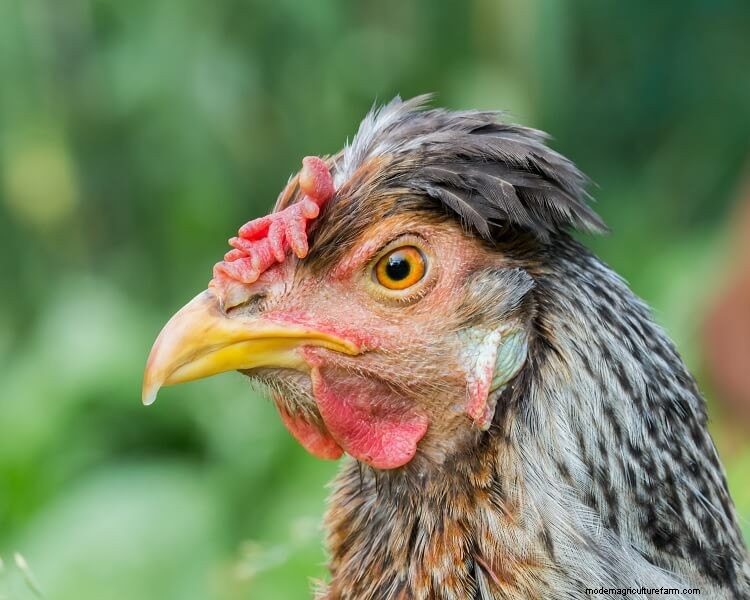
El Cream Legbar fue creado en el Reino Unido en la década de 1930 por el profesor Punnett. He was trying to create a bird that laid blue eggs and was also auto-sexing.
He succeeded with the Legbar.
The chicks can be sexed at hatching so there should not be any accidental roosters found in the bunch. They are a good egg layer giving 3-4 medium sized light blue eggs each week.
Blue eggs come from the Araucana parentage.
Their other genetic makeup comes from the Leghorn and Barred Rock.
In general they are a friendly and docile breed that is easily handled.
| Cream Legbar |
|---|
| Main Use: Eggs |
| Yearly Egg Production: 175-250 |
| Egg Color: Blue |
| Beginner Friendly: Yes |
| Temperament: Friendly |
| Noise Level: Normal |
| Preferred Climate: Any |
Easter Egger
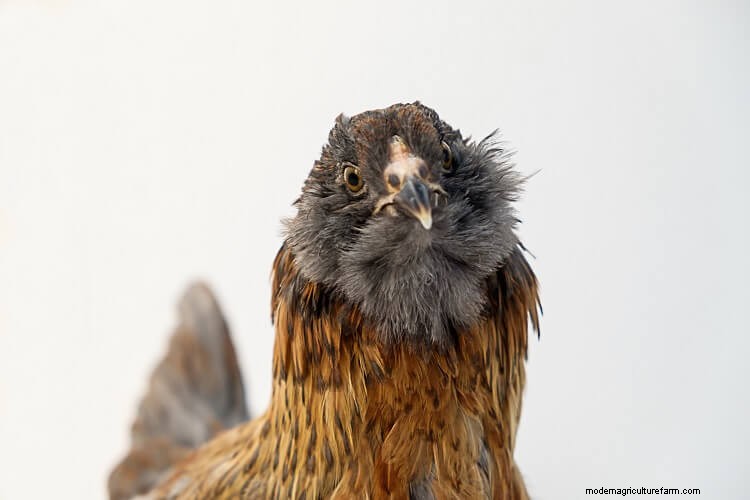
The Easter Egger is a cheerful and happy hen.
They are best known as a friendly breed that is great with kids and enjoys lap time too.
Whilst this breed is technically a hybrid, they are highly sought after because of their colored eggs.
They can lay blue, olive, green and even pinkish colored eggs . Whichever color your hen lays will be the only color she lays – they are not individual rainbow makers!
She is tolerant of a wide range of temperatures and climates and is generally low maintenance.
| Easter Egger |
|---|
| Main Use: Eggs |
| Yearly Egg Production: 175-250 |
| Egg Color: Rainbow (Other) |
| Beginner Friendly: Yes |
| Temperament: Docile |
| Noise Level: Quiet |
| Preferred Climate: Any |
Golden Comet
The Golden Comet is another hybrid Red Sex Link Chicken.
She was only used for the poultry industry however this lovely lady has become a backyard favorite.
This breed has a peaceful, calm and gentle personality. They love their humans and children as well as lap time.
They are egg laying superstars giving 5-6 eggs a week. Unfortunately as they have been bred to lay eggs they usually have a short life (less than 5 years).
She is a hardy little hen and tolerates both hot and cold climates. They love to free range but will tolerate confinement with sufficient room.
| Golden Comet |
|---|
| Main Use: Eggs |
| Yearly Egg Production: 250+ |
| Egg Color: Brown |
| Beginner Friendly: Yes |
| Temperament: Docile |
| Noise Level: Normal |
| Preferred Climate: Any |
Hamburg
The Hamburg chicken has been traced back to fourteenth century Holland where they are thought to have originated. They are sometimes known as Moonies because of their plumage.
They are a small breed, with hens only weighing 4lb.
The breed is quite hard to find and is on the Livestock Conservancy watch list.
Her personality is active and somewhat flighty – they are very predator savvy and fly well.
| Hamburg |
|---|
| Main Use: Eggs |
| Yearly Egg Production: 175-250 |
| Egg Color: White |
| Beginner Friendly: No |
| Temperament: Skittish |
| Noise Level: Normal |
| Preferred Climate: Any |
ISA Brown
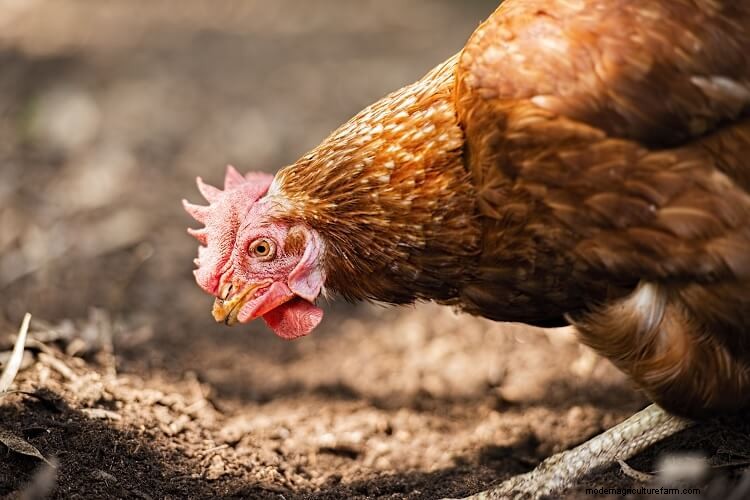
The ISA Brown was bred from the Institut de Selection Animale.
They are also known as a Hubbard ISA and their exact genetic makeup is a closely guarded secret and was patented back in 1978.
ISA Browns were bred as egg laying machines for the poultry industry and they will put out 5-6 large brown eggs each week for the first 18 months or so, then production will drop off a bit.
Sadly they have a very short lifespan of 2-3 years – all that egg laying is rough on their body.
They are affectionate hens and often enjoy a special bond with their humans with lots of lap time and cuddles.
| ISA Brown |
|---|
| Main Use: Eggs |
| Yearly Egg Production: 250+ |
| Egg Color: Brown |
| Beginner Friendly: Yes |
| Temperament: Docile |
| Noise Level: Normal |
| Preferred Climate: Any |
Isbar
Created in the 1950s by a Catholic priest, the Isbar is a relatively new breed. As a result they have not yet admitted to the American Poultry Association.
They are small with hens weighing 3-3.5lb. They can be used as a dual purpose chicken but are more commonly kept for their eggs.
Expect an intelligent, calm and easy going hen that is friendly to their humans.
Hens will lay 3-4 green eggs each week – the depth of green can vary from light sage to moss green.
As they were created in Sweden they are quite cold tolerant with beautiful dense feathering.
They are good foragers and prefer to free range to confinement.
Interestingly they are also auto-sexing which means that chicks can be sexed at hatching.
| Isbar |
|---|
| Main Use: Eggs |
| Yearly Egg Production: 175-250 |
| Egg Color: Rainbow (Other) |
| Beginner Friendly: Yes |
| Temperament: Docile |
| Noise Level: Normal |
| Preferred Climate: Cold Hardy |
Jaerhon
The Jaerhon is the only chicken breed that comes from Norway .
It was developed in the 1920s from the Landrace birds of Norway (all of whom are now extinct).
They are small but prolific layers of white eggs. The hens are not known for broodiness so their mothering skills are unknown.
They love to free range and are very predator aware. They are active, love to roam and fly very well. This breed is friendly towards their handlers and are also quiet.
The Jaerhon comes in two color varieties:light and dark. Surprisingly there is also a bantam variety.
| Jaerhon |
|---|
| Main Use: Eggs |
| Yearly Egg Production: 250+ |
| Egg Color: White |
| Beginner Friendly: Yes |
| Temperament: Friendly |
| Noise Level: Quiet |
| Preferred Climate: Cold Hardy |
Langshan
The Langshan first made its appearance in England in the late 1800s when it was imported from China.
It is a large dual purpose chicken with a very upright carriage. They are active and prefer to range but they do take to confinement well enough.
Interestingly they are the only hen known to lay a plum colored egg.
The hens weigh in at around 6.5lb and are good layers putting out 3 large eggs per week.
Overall they are calm, docile and friendly to their humans.
| Langshan |
|---|
| Main Use: Eggs |
| Yearly Egg Production: 100-170 |
| Egg Color: Rainbow (Other) |
| Beginner Friendly: Yes |
| Temperament: Docile |
| Noise Level: Normal |
| Preferred Climate: Any |
Olive Egger
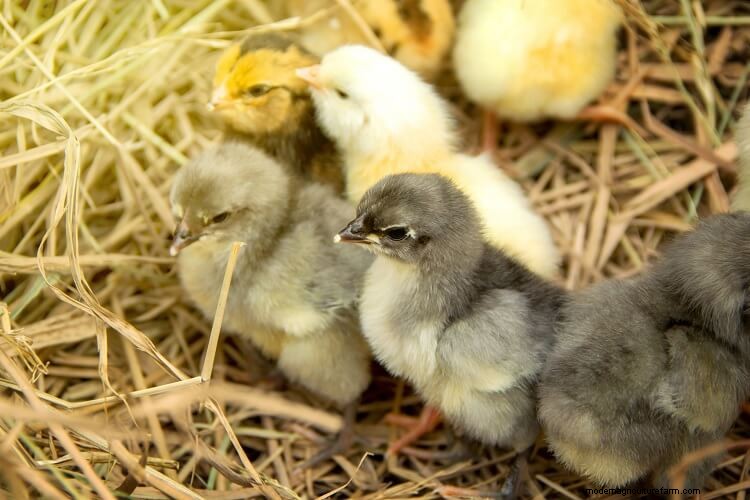
Olive Eggers are technically a hybrid and are a fairly new introduction to the chicken scene.
They are the result of crossing a dark brown egg layer with a blue egg layer (for example an Ameraucana hen with a Welsummer rooster).
Their looks can vary but the hens will lay an olive colored egg.
They can be used as dual purpose (hens weigh around 5-6lb) but they are usually kept more for eggs. They are winter hardy and love foraging although they will tolerate confinement very well.
This is a friendly and docile hen that does well with children.
| Olive Egger |
|---|
| Main Use: Eggs |
| Yearly Egg Production: 100-170 |
| Egg Color: Rainbow (Other) |
| Beginner Friendly: Yes |
| Temperament: Docile |
| Noise Level: Normal |
| Preferred Climate: Any |
Plymouth Rock
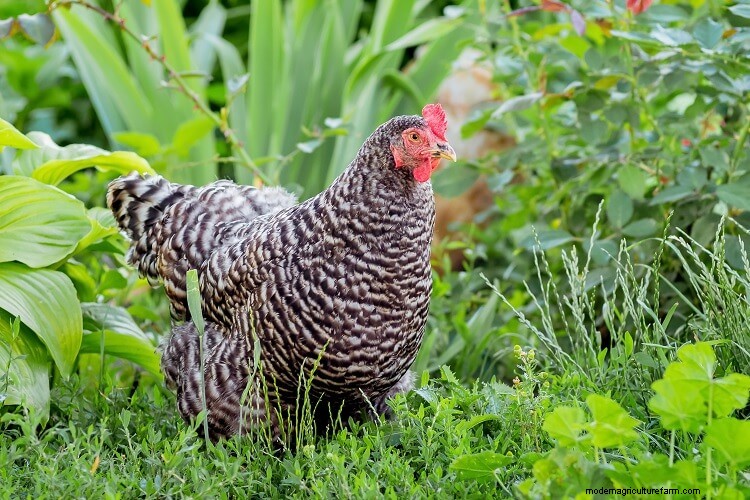
The Plymouth Rock is one of the most dependable breeds around today. She has been going strong since the 1800s and remains very popular today.
This breed is not as fast to mature as the industrial chickens of today, but they are well worth the wait!
Hens come in at 7lb and will lay a steady 4-5 light brown eggs.
They are also an autosexing breed which means you can tell the boys from the girls as soon as they hatch.
This is a docile, inquisitive and friendly breed that is suitable for kids. There are several color varieties to choose from and they come in standard or bantam size.
| Plymouth Rock |
|---|
| Main Use: Eggs |
| Yearly Egg Production: 250+ |
| Egg Color: Brown |
| Beginner Friendly: Yes |
| Temperament: Docile |
| Noise Level: Normal |
| Preferred Climate: Any |
Red Sex Link
The Red Sex Link is a hybrid breed.
As a hybrid they have been selected for egg laying which means they lay very well.
Most of them make delightful backyard hens. They are friendly, docile and love to be pet and held, making them perfect for kids. Occasionally you can get aggressive strains but it is unusual.
Sadly these chickens have a short lifespan (not much more than 3 years at best).
You can find Red Sex Links under a variety of names:Golden Comet, Red Star, Bovans Brown and ISA brown to name a few.
| Red Sex Link |
|---|
| Main Use: Eggs |
| Yearly Egg Production: 250+ |
| Egg Color: Brown |
| Beginner Friendly: Yes |
| Temperament: Docile |
| Noise Level: Normal |
| Preferred Climate: Any |
Swedish Black Hen
The origins of the Swedish Black Hen are uncertain, but what we do know is this breed was found in Sweden.
This is a landrace bird that is a rare fibromelanistic chicken similar to the Ayam Cemani.
Also known as the Svart Hona, they love to free range and are excellent foragers. They enjoy their humans and will often hop into your lap for a treat.
She is a small hen (weighing around 3.5lb) and will lay 3 large eggs each week.
Overall they are a fairly low maintenance breed and can tolerate cold and hot weather.
| Swedish Black Hen |
|---|
| Main Use: Eggs |
| Yearly Egg Production: 100-170 |
| Egg Color: Cream |
| Beginner Friendly: Yes |
| Temperament: Friendly |
| Noise Level: Quiet |
| Preferred Climate: Any |
Swedish Flower Hens
The Swedish Flower hen was relatively unknown until the early 2000s. It is a landrace bird that has evolved for survival in a harsh landscape.
Landrace means there has been no human interference with the breed, so genetic diversity is high.
Because of their genetic diversity they can be crested (or not). The base plumage colors can be:black, yellow or white, but the overall pattern is mille fleur – this gives them a good camouflage against predators.
Hens are decent layers and will lay 3-4 medium eggs each week.
They are a confident and independent hen but are friendly with their humans.
| Swedish Flower Hens |
|---|
| Main Use: Eggs |
| Yearly Egg Production: 100-170 |
| Egg Color: Cream |
| Beginner Friendly: No |
| Temperament: Docile |
| Noise Level: Quiet |
| Preferred Climate: Cold Hardy |
White Leghorn
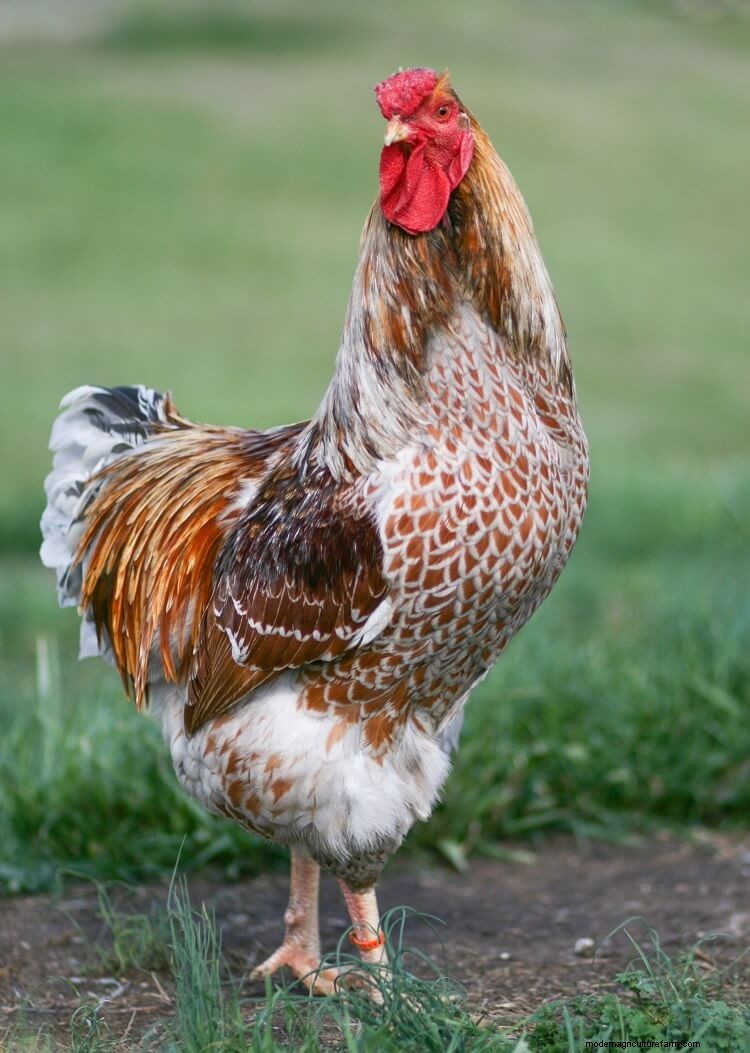
White Leghorn are a color variety of the Leghorn – an ancient breed from Italy.
Being from the Mediterranean they have the typical sleek and slender body.
They are an independent breed that is best described as noisy and flighty. They are certainly not lap chickens.
There are several different varieties of Leghorn but the white is the most prolific layer . They are known to lay 4-6 large white eggs a week.
The Leghorn prefers a warmer climate but can tolerate cool climates.
| White Leghorn |
|---|
| Main Use: Eggs |
| Yearly Egg Production: 250+ |
| Egg Color: White |
| Beginner Friendly: Yes |
| Temperament: Skittish |
| Noise Level: Loud |
| Preferred Climate: Warm Climates |
White Rock
The White Rock is one of the Plymouth Rock varieties.
Created in the US as a dual purpose breed the Rocks are enduring success story. The White Rock has been a favorite with the broiler industry for many years.
It is a great chicken for small farms as it is people friendly and loves to be held which makes it great for kids and novices alike.
The hens are usually around 6lb in weight and good layers of large brown eggs (usually 4-5 per week).
They thrive in colder areas because of their dense feathering and are also available as bantams.
| White Rock |
|---|
| Main Use: Eggs |
| Yearly Egg Production: 250+ |
| Egg Color: Brown |
| Beginner Friendly: Yes |
| Temperament: Docile |
| Noise Level: Normal |
| Preferred Climate: Any |
Whiting True Blue
The Whiting True Blue Chicken is a relatively new breed of chicken. It was created by Dr. Tom Whiting of Colorado in the late 1900s.
He created the chickens for two reasons:egg laying and fly tying.
Apparently the hackle feathers of the True Blue are of superb quality for tying fishing flies.
The hens are good layers and will give you 4 blue eggs each week.
True Blues are docile, curious and friendly towards humans. They are fast growing hens that are good flyers and love to be active. Their plumage is mixed colors with an occasional beard or single comb making an appearance.
| Whiting True Blue |
|---|
| Main Use: Eggs |
| Yearly Egg Production: 175-250 |
| Egg Color: Blue |
| Beginner Friendly: No |
| Temperament: Bold (Self Assured) |
| Noise Level: Normal |
| Preferred Climate: Any |
Dual Purpose
Altsteirer
The Altsteirer is an ancient breed that can be traced back to at least the thirteenth century. They are also known as the Styrian as it was found in the Styrian region of Austria.
This is a very hardy and active dual purpose breed. They are constantly alert and love to free range and fly. Expect a friendly breed, but not lap chickens.
She will mature early and will weigh around 5.5lb.
The hens lay around three large white eggs each week and are not known for being broody.
There are two main varieties:white and partridge but there are other varieties too. All varieties are very rare.
| Altsteirer |
|---|
| Main Use: Dual Purpose |
| Yearly Egg Production: 100-170 |
| Egg Color: White |
| Beginner Friendly: Yes |
| Temperament: Friendly |
| Noise Level: Normal |
| Preferred Climate: Any |
Barnevelder
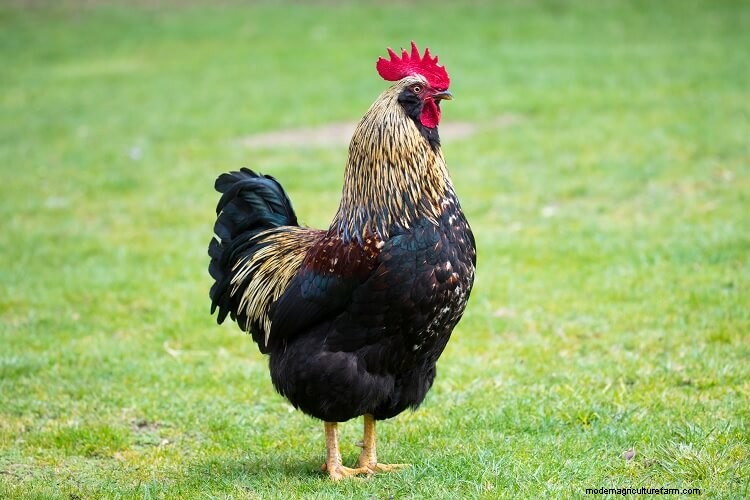
The Barnevelder was created in Holland specifically to lay a dark brown egg. Hens generally produce 3-4 large brown eggs each week (even through the winter).
They are a mix of several different breeds and are considered to be a dual purpose breed.
Once fully grown hens will lay around 5lb (there is a bantam variety too).
As for their personality they are calm and friendly with strong streaks of curiosity and intelligence.
They much prefer to be free ranging but will tolerate confinement pretty well as long as they have sufficient room and things to occupy them.
| Barnevelder |
|---|
| Main Use: Dual Purpose |
| Yearly Egg Production: 175-250 |
| Egg Color: Chocolate |
| Beginner Friendly: Yes |
| Temperament: Friendly |
| Noise Level: Normal |
| Preferred Climate: Any |
Basque
The Basque hen, also known as the Euskal Oiloa, originally comes from the Basque region of Spain.
This is a mountainous area where it is hard to survive. As a result Basque hens are hardy and a very thrifty forager.
There are five varieties with the Marraduna being the most common in the US.
These days it is a rare hen and efforts are being made to preserve this breed in their homeland. They are a remarkably friendly breed, and will not be afraid to jump into your lap to tell you about their day.
Hens will lay around 3 large brown eggs each week and will even lay during the winter.
| Basque |
|---|
| Main Use: Dual Purpose |
| Yearly Egg Production: 175-250 |
| Egg Color: Brown |
| Beginner Friendly: Yes |
| Temperament: Friendly |
| Noise Level: Normal |
| Preferred Climate: Warm Climates |
Blue Laced Red Wyandotte

This is another member of the Wyandotte family that is currently popular. Although the blue lacing on red feathers seems to be the draw right now, this color variety can actually be dated back to the 1900s.
The Wyandotte is very well suited for cold climates as they have a rose comb and dense feathering to keep themselves warm through those long winter nights.
She is a large dual purpose hen and will weigh around 6lb.
Overall she is a peaceful, quiet and dependable breed, that lays 4 large cream/light brown eggs each week. Although they are docile they will not tolerate other breeds picking on them.
They do well in confinement as long as they have enough room, but prefer to free range when they can.
| Blue Laced Red Wyandotte |
|---|
| Main Use: Dual Purpose |
| Yearly Egg Production: 175-250 |
| Egg Color: Brown |
| Beginner Friendly: Yes |
| Temperament: Friendly |
| Noise Level: Quiet |
| Preferred Climate: Any |
Brahma
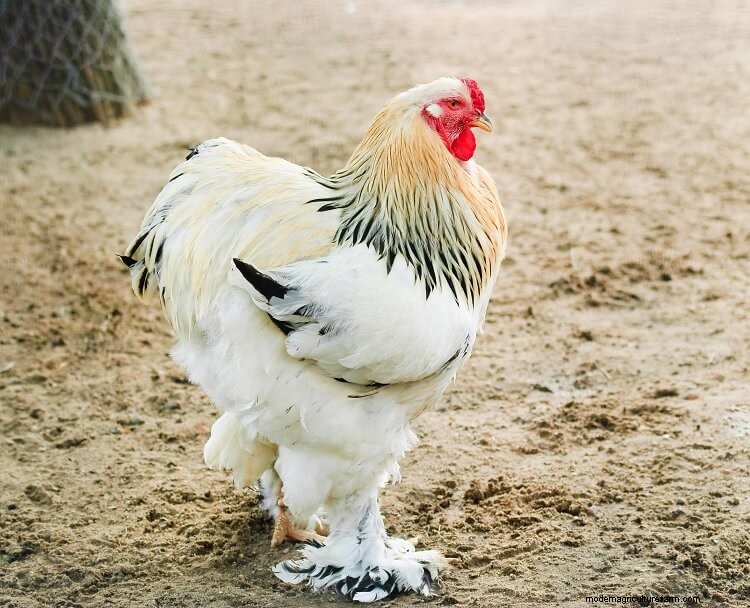
Welcome to the gentle giant of the chicken kingdom.
Brahmas can be huge with boys weighing up to 10lb and hens weighing 8lb!
Their personality is quiet, calm, docile and friendly. They are very tame and do well with children although their size can be a bit intimidating for some kids.
You can expect them to lay 3-4 medium brown eggs each week. And whilst they are not known for being broody, they do make good mothers.
The Brahma is available in both standard and bantam sizes.
| Brahma |
|---|
| Main Use: Dual Purpose |
| Yearly Egg Production: 100-170 |
| Egg Color: Brown |
| Beginner Friendly: Yes |
| Temperament: Friendly |
| Noise Level: Quiet |
| Preferred Climate: Any |
Breda
The Breda is the national bird of the Netherlands.
She is a striking breed and is truly without comparison in the poultry world.
Their head is shaped a bit like a crows’ head, with a large beak and cavernous nostrils. There is no comb just a red patch of skin and a small tuft
The Breda was very popular here in the US prior to the Civil War and then just faded away. They are slowly making a come-back but are considered endangered even in Holland.
Bredas weigh around 5-6lb and will lay 3 large white eggs each week. They are a shy chicken but are friendly, docile, alert and always curious.
| Breda |
|---|
| Main Use: Dual Purpose |
| Yearly Egg Production: 100-170 |
| Egg Color: White |
| Beginner Friendly: Yes |
| Temperament: Skittish |
| Noise Level: Normal |
| Preferred Climate: Any |
Buckeye
The Buckeye is the only American hen to have a pea comb . It is also the only breed that was created by a woman. They are called Buckeyes because their deep red plumage resembles the color of the buckeye nut.
They can thrive in cold climates because of their pea comb and tight feathering.
Buckeyes are more suited to free ranging, but should be kept in a safe area as they are not entirely predator savvy.
They are a good dual purpose breed, with hens laying 3-4 eggs a week.
She is an active breed and said to be great mousers. They are peaceful and friendly with their humans.
| Buckeye |
|---|
| Main Use: Dual Purpose |
| Yearly Egg Production: 175-250 |
| Egg Color: Brown |
| Beginner Friendly: Yes |
| Temperament: Docile |
| Noise Level: Quiet |
| Preferred Climate: Any |
Buff Orpington
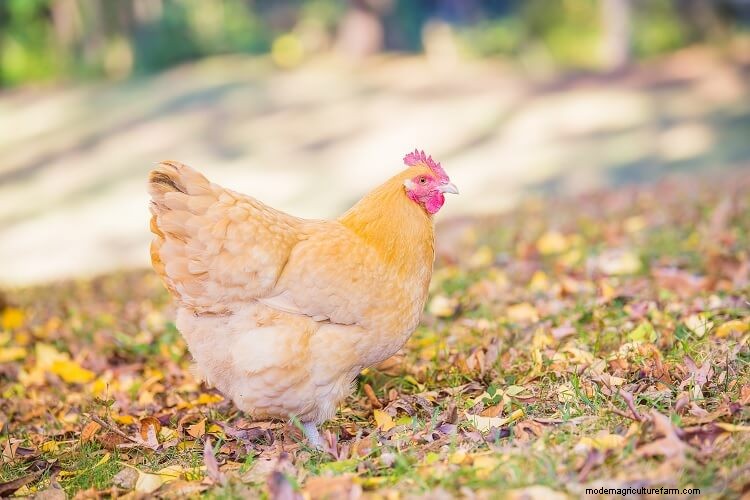
Welcome to the most popular variety of the Orpington tribe.
The Buff is loved all over the world and returns this love right back. She is a cuddly and calm breed that enjoys lap time and being picked up.
Buff Orpingtons are large chickens that weight around 8lb. She is a good layer putting out between 3-5 large light brown eggs per week.
The only negative thing to say about them is that they can be annoyingly broody, but if you want to raise chicks the Orpington will oblige.
Finally, they do need to be monitored for obesity as they are heavy feeders.
| Buff Orpington |
|---|
| Main Use: Dual Purpose |
| Yearly Egg Production: 175-250 |
| Egg Color: Brown |
| Beginner Friendly: Yes |
| Temperament: Friendly |
| Noise Level: Quiet |
| Preferred Climate: Any |
Catalana
The Catalana originated in Spain and unusually for a Mediterranean breed is dual purpose.
Hens are good layers putting out 4 large white eggs a week and are rarely broody.
Unfortunately this breed has not caught on in the US yet, but they are very popular in Spain and Latin America.
She is known as an active and independent breed that loves to forage. They can be noisy so an urban environment is not for them. You will also notice she flys well and roosts high.
They come in two sizes:standard and bantam.
| Catalana |
|---|
| Main Use: Dual Purpose |
| Yearly Egg Production: 175-250 |
| Egg Color: White |
| Beginner Friendly: No |
| Temperament: Skittish |
| Noise Level: Loud |
| Preferred Climate: Warm Climates |
Chantecler
The Chantecler is Canadas first chicken breed.
They were bred in a Quebec monastery with the intention of producing a good dual purpose chicken that could survive the Canadian winters.
She tolerates the cold very well but does not like the heat so much.
Chanteclers have small wattles, a cushion comb and dense feathering. They come in two colors:white and partridge.
Overall they are a friendly and personable breed that is calm and gentle.
| Chantecler |
|---|
| Main Use: Dual Purpose |
| Yearly Egg Production: 175-250 |
| Egg Color: Brown |
| Beginner Friendly: Yes |
| Temperament: Docile |
| Noise Level: Quiet |
| Preferred Climate: Any |
Columbian Wyandotte
The Colombian Wyandotte is one of the prettier Wyandotte varieties.
They are large birds and can weigh between 6-9lb.
In addition to this she is a good layer and will produce 4-5 large light brown eggs a week.
Hens do occasionally go broody and make attentive mothers.
Personality wise they are quiet, calm and docile. However they do not enjoy being picked up or held. They do equally well confined or free ranging but if they are allowed to roam they are great foragers.
They are suitable for an urban environment and come in standard and bantam sizes.
| Columbian Wyandotte |
|---|
| Main Use: Dual Purpose |
| Yearly Egg Production: 175-250 |
| Egg Color: Brown |
| Beginner Friendly: Yes |
| Temperament: Docile |
| Noise Level: Quiet |
| Preferred Climate: Any |
Cuckoo Marans
The Cuckoo Marans is one of several varieties of Marans chickens.
This French breed was developed over the centuries and an official standard was established in the 1920s.
The hens are very sought after because they lay chocolate colored eggs.
However they are not the most prolific layers, giving around 3 large per week.
This is a winter hardy chicken and a good forager. They are said to mature fairly quickly and once fully grown a hen will weight 7-8lb. They will tolerate confinement but prefer to free range.
| Cuckoo Marans |
|---|
| Main Use: Dual Purpose |
| Yearly Egg Production: 100-170 |
| Egg Color: Chocolate |
| Beginner Friendly: No |
| Temperament: Docile |
| Noise Level: Quiet |
| Preferred Climate: Any |
Delaware
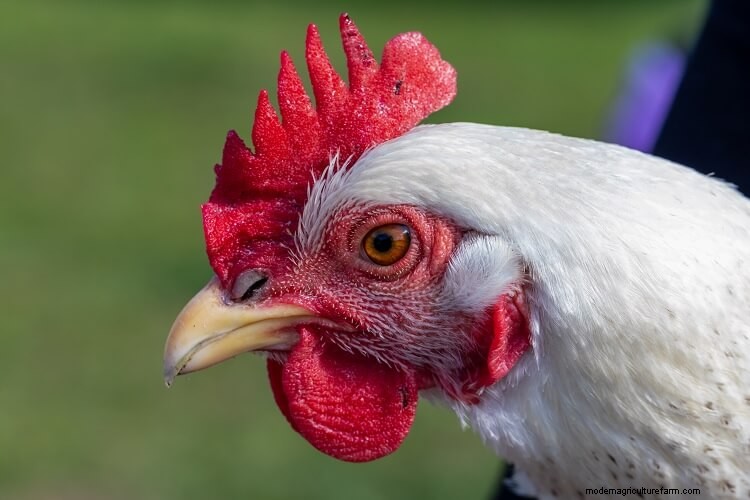
The Delaware was created around the 1940s and was destined to become the broiler chicken of the industry.
Originally called Indian Rivers they were extremely popular because they laid well and were fast growing. However they were surpassed in growth by the Cornish Cross, which became the broiler hen of the century.
Delawares are calm and curious hens that are personable and intelligent.
This sweet breed will be quite talkative too.
Available in both standard and bantam sizes this is a good homesteading breed. Hens will lay 4 large brown eggs a week and rarely go broody.
| Delaware |
|---|
| Main Use: Dual Purpose |
| Yearly Egg Production: 175-250 |
| Egg Color: Brown |
| Beginner Friendly: Yes |
| Temperament: Docile |
| Noise Level: Normal |
| Preferred Climate: Any |
Derbyshire Redcap
The Red Cap is an old English breed. It is also known as a Coral cap.
They are an active but shy breed and are well suited for free ranging.
Derbyshire Redcaps are relatively pure since there has been little cross breeding with this breed. They have a stunning rose comb (hence the name Red Cap) and will reach around 6lb.
They were especially popular in the north of England however these days she is critically endangered.
The hens are not prolific layers but will give you a respectable 3-4 medium white eggs each week.
| Derbyshire Redcap |
|---|
| Main Use: Dual Purpose |
| Yearly Egg Production: 175-250 |
| Egg Color: White |
| Beginner Friendly: No |
| Temperament: Skittish |
| Noise Level: Normal |
| Preferred Climate: Any |
Dominique
The Dominique hen is considered to be one of America’s oldest breeds.
They are also known as Pilgrim fowl as they are thought to have descended from the original breeds brought by the pilgrims.
She is a small hen and will only weigh around 5lb.
Their plumage is a black and white staggered barring pattern which helps them hide from predators. Their dense plumage and rose comb makes them a cold hardy breed.
In general they are a calm, docile and friendly breed. They are active, hardy and a fairly low maintenance breed.
Occasionally they will go broody and they make great mothers.
| Dominique |
|---|
| Main Use: Dual Purpose |
| Yearly Egg Production: 175-250 |
| Egg Color: Brown |
| Beginner Friendly: Yes |
| Temperament: Docile |
| Noise Level: Quiet |
| Preferred Climate: Any |
Dorking
The exact history of the Dorking is unclear but they are thought to have originated from England. You may occasionally find this breed is called old five toes.
They evolved from the Landrace Chicken and remain a slow grower by today’s standards.
Hens will grow to around 6lb and Roosters will get heavier.
You should expect a shy and gentle chicken. They like to free range but will tolerate confinement fairly well.
They are one of the few hens with red earlobes that produce white eggs. They are attentive and devoted mothers and are quite broody.
| Dorking |
|---|
| Main Use: Dual Purpose |
| Yearly Egg Production: 175-250 |
| Egg Color: White |
| Beginner Friendly: No |
| Temperament: Docile |
| Noise Level: Quiet |
| Preferred Climate: Cold Hardy |
Faverolles
The Faverolles is an old French breed that is used as a dual purpose bird.
They have a happy personality, love to chat with you, are friendly, gentle and docile.
Their plumage is quite dense and they have beards, muffs and feathered feet which gives them an even fluffier appearance.
The most popular variety of Faverolles is the salmon color , which is more of a honey brown tone.
Hens are good layers of large tinted eggs. They do occasionally go broody and make good mothers.
The Faverolles love to free range but tolerate confinement with plenty of space.
| Faverolles |
|---|
| Main Use: Dual Purpose |
| Yearly Egg Production: 175-250 |
| Egg Color: Brown |
| Beginner Friendly: Yes |
| Temperament: Friendly |
| Noise Level: Normal |
| Preferred Climate: Any |
Golden Laced Wyandotte
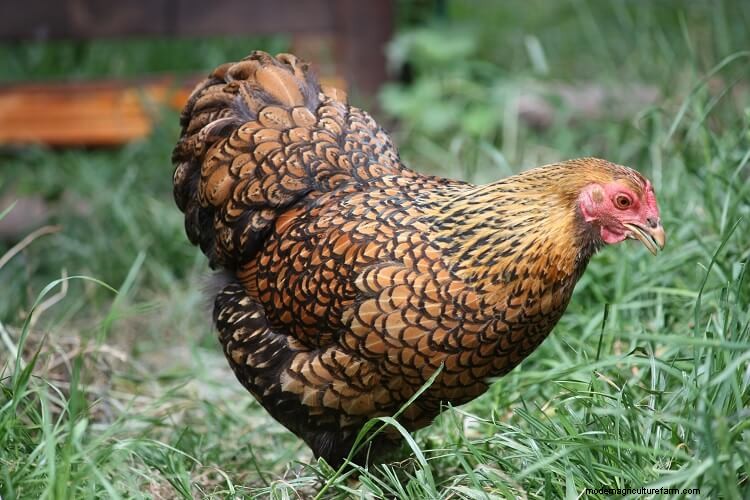
The Golden Laced Wyandotte is one of Americas’ premier breeds!
She is cold hardy, productive and low maintenance.
Once fully grown she will reach around 6lb, however if you are restricted with space then bantams are available.
They are an independent minded hen and prefer the company of their own breed. Whilst she is friendly enough to humans, she does not enjoy being picked up or cuddled.
Their independent nature and low maintenance requirements makes them ideal for novices and 4H programs.
| Golden Laced Wyandotte |
|---|
| Main Use: Dual Purpose |
| Yearly Egg Production: 175-250 |
| Egg Color: Brown |
| Beginner Friendly: Yes |
| Temperament: Bold (Self Assured) |
| Noise Level: Quiet |
| Preferred Climate: Any |
Icelandic
Icelandic chickens are a rare gem . They are almost genetically pure which seems to keep them pretty healthy and disease free.
They were left in Iceland by the Vikings who had selected the best utilitarian chickens they could find. As a Landrace Chicken there is no standard and they come in a wide variety of colors, patterns and plumage types.
As you would expect, they are great foragers and can virtually feed themselves. They are extremely hardy to most climates, fly well and very predator savvy.
Given their history this breed will never be cuddly, but they will become friendly and trusting of you if given time.
Hens will only weigh around 3lb.
| Icelandic |
|---|
| Main Use: Dual Purpose |
| Yearly Egg Production: 100-170 |
| Egg Color: White |
| Beginner Friendly: Yes |
| Temperament: Bold (Self Assured) |
| Noise Level: Normal |
| Preferred Climate: Cold Hardy |
Iowa Blue
Unfortunately the Iowa Blue is a rare breed these days.
They were created around the 1900s in Iowa and quickly gained popularity in small farms and homesteads.
This is a large breed that will weigh between 5-6lb. Hens are good layers and will give you 3-4 eggs each week. Also the ladies have a tendency towards broodiness and make good mothers.
Roosters are known for being great flock defenders and their nickname is hawk fighter!
The breed does best in a free range situation as it is a great forager and alert to danger.
You can expect a fairly calm and docile chicken that is tolerant of a wide range of temperatures and environments.
| Iowa Blue |
|---|
| Main Use: Dual Purpose |
| Yearly Egg Production: 100-170 |
| Egg Color: Brown |
| Beginner Friendly: Yes |
| Temperament: Docile |
| Noise Level: Normal |
| Preferred Climate: Any |
Java
The Java is the second oldest breed in the US behind the Dominique. Despite their name they were developed in the US sometime around the mid-1800s.
They were critically endangered at one time but are slowly making a comeback.
She is very well suited to small farms and homesteads.
They are a dual purpose chicken and will lay 3 large brown eggs a week.
This breed loves to range and when allowed they will supplement their diet very well. You can find them in three varieties (black, white and mottled).
Expect a friendly, docile and calm breed that is easily handled.
| Java |
|---|
| Main Use: Dual Purpose |
| Yearly Egg Production: 100-170 |
| Egg Color: Brown |
| Beginner Friendly: Yes |
| Temperament: Docile |
| Noise Level: Normal |
| Preferred Climate: Any |
Jersey Giant
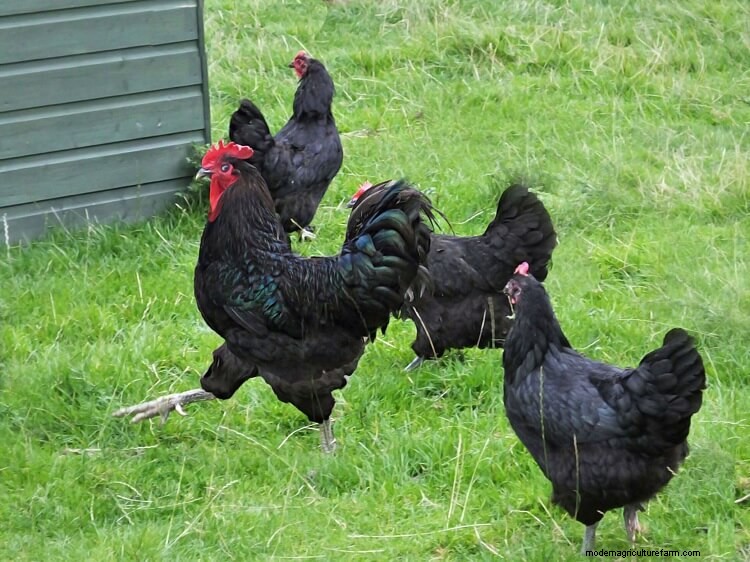
The Jersey Giant was created in New Jersey back in the 1800s.
It was originally intended to rival the turkey’s place at the table.
As you would expect this is a large chicken that stands around 2 feet tall. Males will weigh 13-15lb and hens around 11lb.
Given their size you will need to have larger pens, doors and nest boxes available for them. Also make sure to place perches slightly lower to the floor.
Jersey Giants are calm, gentle and love to forage. This is a good thing as they are expensive to feed so letting them roam will reduce their feed bill slightly. They are not known for being broody, but sadly when they do, they often break the eggs with their weight or step on the chicks accidentally.
They are suitable for beginners and children – although their size can be a bit intimidating!
| Jersey Giant |
|---|
| Main Use: Dual Purpose |
| Yearly Egg Production: 175-250 |
| Egg Color: Brown |
| Beginner Friendly: Yes |
| Temperament: Docile |
| Noise Level: Normal |
| Preferred Climate: Any |
Lavender Orpington
The Lavender Orpington is one of the newer additions to the Orpington family.
They were first bred in the 1990s and have really taken off in popularity.
The Lavender color is due to a recessive diluting gene that dilutes black to a pale grey/pearl grey or lavender.
Orpingtons are large fluffy hens that look enormous. They are a dual purpose hen but the lavender strain often is an exhibition or show bird too.
Hens are notoriously broody and make great mothers and will raise most eggs placed under them. When they are not broody they will lay 3-4 large tinted eggs each week.
Orpingtons are inclined to be lazy and whilst they do forage they will prefer to sit by the feeder. Their weight should be monitored as obese hens can have serious problems with egg laying.
They are gentle, quiet, docile and make great beginner chickens.
| Lavender Orpington |
|---|
| Main Use: Dual Purpose |
| Yearly Egg Production: 175-250 |
| Egg Color: Brown |
| Beginner Friendly: Yes |
| Temperament: Docile |
| Noise Level: Quiet |
| Preferred Climate: Any |
Light Brahma
The Light Brahma is a color variation of the Brahma.
They have a light colored plumage and are quite large. However despite their appearance they are a gentle giant!
Brahmas are calm, friendly and quiet, so are well suited for beginners.
The hens are good layers and will produce around 4 brown eggs per week.
| Light Brahma |
|---|
| Main Use: Dual Purpose |
| Yearly Egg Production: 100-170 |
| Egg Color: Brown |
| Beginner Friendly: Yes |
| Temperament: Friendly |
| Noise Level: Quiet |
| Preferred Climate: Any |
Marsh Daisy
The Marsh Daisy is sadly in need of people to help conserve the breed.
She was created in the 1800s in Lancashire (England) and is a beautiful hen well suited to small farms and homesteads.
The name Marsh Daisy may come from their oversized rose comb which is said to look like a Marsh Daisy.
They are slow to mature but they are very economical since they love to free range and are very active foragers.
Although they cannot really be described as friendly, they are pretty calm yet aloof.
Hens weigh around 5.5lb and will lay 2-3 medium tinted eggs each week. They are occasionally broody and make good mothers.
They come in five color varieties but some are very rare and hard to find.
| Marsh Daisy |
|---|
| Main Use: Dual Purpose |
| Yearly Egg Production: 100-170 |
| Egg Color: Cream |
| Beginner Friendly: Yes |
| Temperament: Bold (Self Assured) |
| Noise Level: Normal |
| Preferred Climate: Any |
Minorca
The Minorca was developed in the late 1700s and comes to us from the Balearic Islands of the Mediterranean.
Also known as the Moorish chicken, or the Red faced Black Spanish, they are the largest of the Mediterranean breeds standing tall with a long tail.
Notably they have large white earlobes and can have either a single or rose comb.
Hens have a good temperament and really enjoy their humans. They can still be a bit flighty on occasions but are generally calm and docile.
You can expect excellent foragers that prefer warmer climates.
| Minorca |
|---|
| Main Use: Dual Purpose |
| Yearly Egg Production: 175-250 |
| Egg Color: White |
| Beginner Friendly: No |
| Temperament: Skittish |
| Noise Level: Normal |
| Preferred Climate: Warm Climates |
New Hampshire
The New Hampshire breed was created in the State of New Hampshire around 1918 as a dual purpose hen.
Unfortunately they have always been overshadowed by the Rhode Island Red which was created around the same time.
They are friendly hens that tend to make good pets and are easy to tame (so are ideal for kids). However they can be food aggressive with other breeds, so be careful when mixing with other breeds.
The hens weigh in at 6.5lb and are good layers of large tinted eggs. They also have a broody tendency and make great mothers.
New Hampshires come in both standard and bantam sizes, but both are hard to find.
| New Hampshire |
|---|
| Main Use: Dual Purpose |
| Yearly Egg Production: 250+ |
| Egg Color: Brown |
| Beginner Friendly: Yes |
| Temperament: Docile |
| Noise Level: Normal |
| Preferred Climate: Any |
Orpingtons
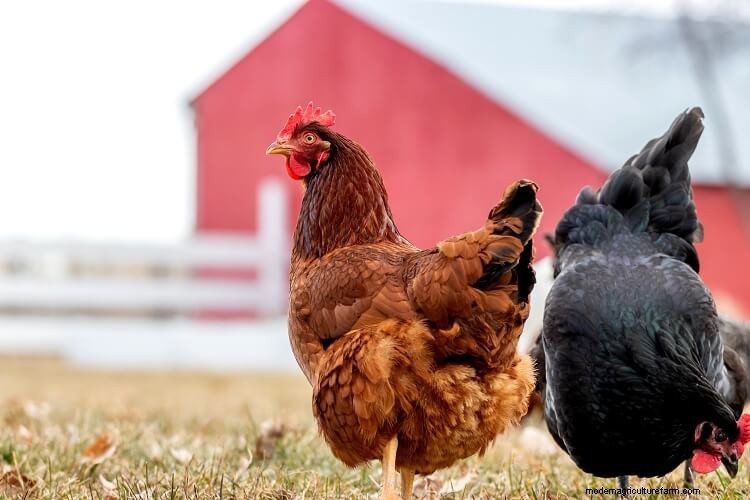
To this day the Orpington breed is a favorite of many small farms and backyard poultry enthusiasts.
This is a large dual purpose chicken that is a prolific egg layer.
She will make a great attentive mother too.
They are large and have copious feathering which comes in several varieties – buff is regarded as the favorite.
Orpingtons are docile, gentle and calm. They are quiet too so urban living could be for them.
This is a great hen for novices and children and will frequently become lap chickens.
| Orpingtons |
|---|
| Main Use: Dual Purpose |
| Yearly Egg Production: 175-250 |
| Egg Color: Brown |
| Beginner Friendly: Yes |
| Temperament: Docile |
| Noise Level: Quiet |
| Preferred Climate: Any |
Red Ranger
The Red Ranger is a dual purpose hybrid chicken that was initially made for the meat market.
Hens are good layers of large brown eggs and will usually lay 3-4 each week.
She is rarely broody and unlike the Cornish Cross, this breed will live for several years.
These hens love to free range and are excellent foragers which can help reduce feed costs.
| Red Ranger |
|---|
| Main Use: Dual Purpose |
| Yearly Egg Production: 175-250 |
| Egg Color: Brown |
| Beginner Friendly: No |
| Temperament: Docile |
| Noise Level: Normal |
| Preferred Climate: Any |
Rhode Island Red

Next to the Orpington, this is possibly the most well known chicken breed worldwide
This breed was created in the mid 1800s in Rhode Island – their fame is such that it is the state chicken there.
They are excellent layers and are rarely broody. They do well in confinement or free range and are a very low maintenance chicken to keep.
Rhode Island Reds are docile and friendly with humans, but can be pushy with other breeds. They can be quite noisy too so urban living really would not suit them.
| Rhode Island Red |
|---|
| Main Use: Dual Purpose |
| Yearly Egg Production: 250+ |
| Egg Color: Brown |
| Beginner Friendly: Yes |
| Temperament: Bold (Self Assured) |
| Noise Level: Loud |
| Preferred Climate: Any |
Sicilian Buttercup
The Sicilian Buttercup is an unusual looking breed.
Their comb is shaped more like a crown and it is the only breed with such a comb . Also the plumage of the hens and roosters is totally different with the ladies having a spangled appearance.
Originating in Sicily, this breed has the typical slender Mediterranean build. Although it can be used as a dual purpose hen, it is not very meaty. They tolerate heat very well but do not tolerate confinement at all as they are an active and restless chicken.
Egg laying is considered to be low to moderate with 2-3 large white eggs per week. The hens are not broody by nature.
Buttercups have a very good feed conversion ratio which makes them fairly inexpensive to feed.
| Sicilian Buttercup |
|---|
| Main Use: Dual Purpose |
| Yearly Egg Production: 100-170 |
| Egg Color: White |
| Beginner Friendly: No |
| Temperament: Bold (Self Assured) |
| Noise Level: Normal |
| Preferred Climate: Warm Climates |
Silver Laced Wyandotte
This variety of Wyandotte is actually the first of its breed.
The breeders were looking for a good dual purpose hen since none existed at that time.
Wyandottes were created to thrive in the cold winters of New York and Michigan.
Hens will lay 4 large eggs each week and are not known for being broody. Their personality is a little distant although they are friendly enough with humans.
This variety too is available in standard and bantam sizes.
| Silver Laced Wyandotte |
|---|
| Main Use: Dual Purpose |
| Yearly Egg Production: 175-250 |
| Egg Color: Brown |
| Beginner Friendly: Yes |
| Temperament: Bold (Self Assured) |
| Noise Level: Quiet |
| Preferred Climate: Any |
Speckled Sussex
The Speckled Sussex is one variety of the very old Sussex breed. This breed has been around since the Roman invasion of Britain.
This is a dual purpose chicken that dresses out to a good 7lb for hens.
Hens are good layers but they do have a slight tendency towards broodiness.
Personality-wise they are a calm, docile and friendly bird. They do well with children and can become tame enough to sit in your lap. They are quite cold hardy but do not enjoy the heat so much. If allowed to free range they are excellent foragers but they do tolerate confinement well.
They are available in both standard and bantam sizes.
| Speckled Sussex |
|---|
| Main Use: Dual Purpose |
| Yearly Egg Production: 250+ |
| Egg Color: Brown |
| Beginner Friendly: Yes |
| Temperament: Docile |
| Noise Level: Normal |
| Preferred Climate: Cold Hardy |
Sussex
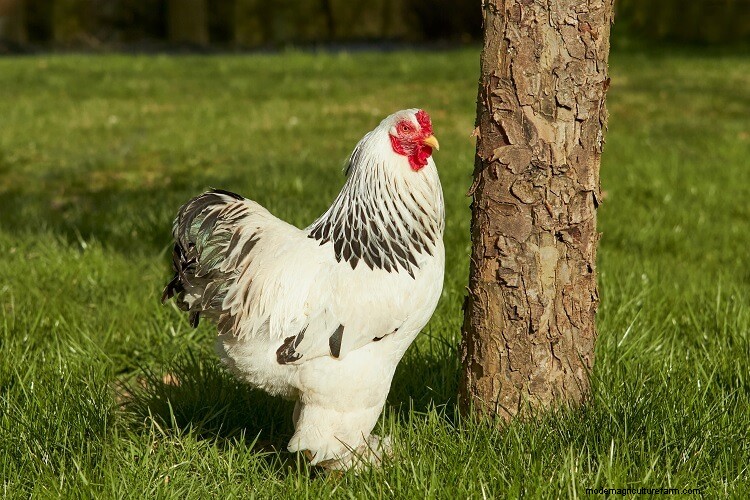
The Sussex is an ancient English hen and has been around for centuries.
They were kept as a dual purpose chicken and in their heyday supplied London with meat for the markets.
This is a dual purpose breed that will put out 4-5 large brown eggs a week. Hens are known for being a bit broody but they do make great mothers.
They do well in confinement but excel when allowed to free range and this will reflect in the feed bill (they are excellent scavengers).
Overall they are a mellow, low maintenance breed that is available in standard or bantam size and is suitable for kids or as a lap chicken.
| Sussex |
|---|
| Main Use: Dual Purpose |
| Yearly Egg Production: 250+ |
| Egg Color: Brown |
| Beginner Friendly: Yes |
| Temperament: Docile |
| Noise Level: Normal |
| Preferred Climate: Cold Hardy |
Turken (Naked Neck)
The Turken, also known as the Naked Neck, is a strange looking chicken.
They have no neck or hackle feathers and sparse feathering around their vent.
It is thought they originated from Transylvania, which explains their other nicknames:the Transylvanian naked neck or Kaalnek.
They like to forage and roam, but they will tolerate confinement. If they are allowed to range they are good foragers, active and vigorous. They are generally a placid and calm hen.
This breed does better in warmer areas but will be hardy enough in cold areas with some protection.
| Turken |
|---|
| Main Use: Dual Purpose |
| Yearly Egg Production: 100-170 |
| Egg Color: Brown |
| Beginner Friendly: No |
| Temperament: Friendly |
| Noise Level: Normal |
| Preferred Climate: Any |
Vorwerk
The Vorwerk was created in Germany around the 1900s. Its purpose was as a dual breed breed.
It is a handsome chicken with black and buff plumage. A hen weighs around the 5lb mark with roosters around 7lb. They are fast to grow and mature and are very suitable for small farms and homesteads. She is winter hardy to most climates and available in both standard and bantam sizes.
The hens are decent layers of cream eggs – around 3 per week and they lay well throughout the winter. They do like to be active so free ranging is best for them as they are good foragers.
Vorwerks are a calm, docile and friendly hen which makes them good for novices and children.
| Vorwerk |
|---|
| Main Use: Dual Purpose |
| Yearly Egg Production: 100-170 |
| Egg Color: Cream |
| Beginner Friendly: Yes |
| Temperament: Bold (Self Assured) |
| Noise Level: Normal |
| Preferred Climate: Any |
Welsummer
Welsummers originated in Holland around the 1920s and remain very popular in Europe.
Here in the US they are gaining popularity as a dual purpose bird that is great for small farms and homesteads.
They are decent layers and produce 4-5 large dark brown eggs each week. The darkness of their eggs can rival some Marans.
The Welsummer will tolerate confinement but do best when free ranging as they are excellent foragers.
They are a low maintenance breed that is smart, curious and friendly with humans. They can be a bit raucous so urban living is not really for them.
| Welsummer |
|---|
| Main Use: Dual Purpose |
| Yearly Egg Production: 175-250 |
| Egg Color: Chocolate |
| Beginner Friendly: Yes |
| Temperament: Docile |
| Noise Level: Normal |
| Preferred Climate: Any |
Wyandotte
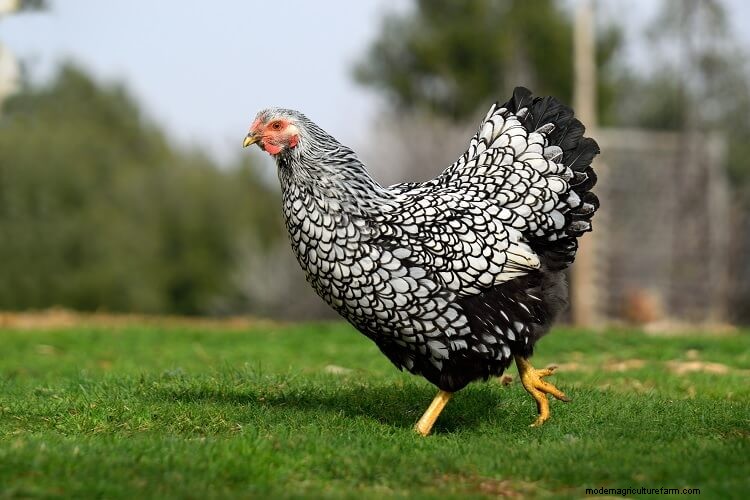
The Wyandotte chicken came into being in the late 1800s. It was created to be a dual purpose breed providing for both meat and eggs.
There is a wide range of varieties to the Wyandottes which we have mentioned here.
They are a large breed with hens weighing around 6lb and roosters around 8lb. The hens are good layers of light brown eggs, usually around 4 per week.
Wyandottes are an aloof chicken, friendly to a point but they do not really enjoy being picked up or held.
They are good for novices as they are low maintenance.
| Wyandotte |
|---|
| Main Use: Dual Purpose |
| Yearly Egg Production: 175-250 |
| Egg Color: Brown |
| Beginner Friendly: Yes |
| Temperament: Bold (Self Assured) |
| Noise Level: Quiet |
| Preferred Climate: Any |
Pets
Cochin
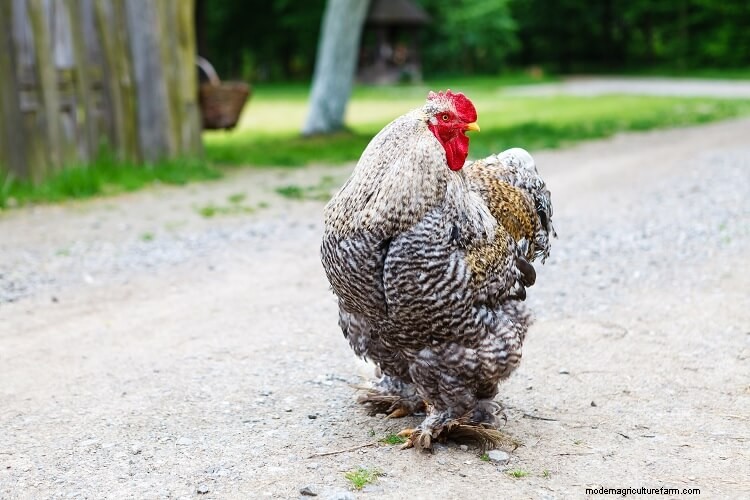
The Cochin was one of the breeds responsible for the hen fever of the late 1800s.
They were new and novel and were crossed with just about every breed known, giving us the richness of breeds that we see today. The Cochin is a large bird and is covered head to toe in feathers. They are slow moving so need to be kept safe from predators.
Their personality is friendly, calm and docile. They love to be lap chickens and adore children.
On the egg laying side, hens are not the best performers. However they do have a tendency towards broodiness so make great moms.
There are also Bantams available.
| Cochin |
|---|
| Main Use: Pet |
| Yearly Egg Production: 100-170 |
| Egg Color: Brown |
| Beginner Friendly: Yes |
| Temperament: Friendly |
| Noise Level: Quiet |
| Preferred Climate: Any |
Frizzle
Depending on which country you live in, the Frizzle may, or may not be a breed.
Here in the US they are not considered a breed but a feather variation of whichever breed they are hatched from (Polish and Cochins are quite prone to frizzles). Just remember that their feathers can be broken easily and the curling affects their ability to fly.
Their feathers curl up and away from the body, looking like a bad hair-do!
You can have your Frizzle in standard or bantam size.
They are a sweet and gentle breed that enjoys being with their humans and make very good show or exhibition birds.
This chicken is a good little forager who enjoys free ranging.
Egg laying will vary on the breed, but expect an average of 3 white eggs each week.
| Frizzle |
|---|
| Main Use: Pet |
| Yearly Egg Production: 100-170 |
| Egg Color: White |
| Beginner Friendly: Yes |
| Temperament: Friendly |
| Noise Level: Normal |
| Preferred Climate: Any |
Polish
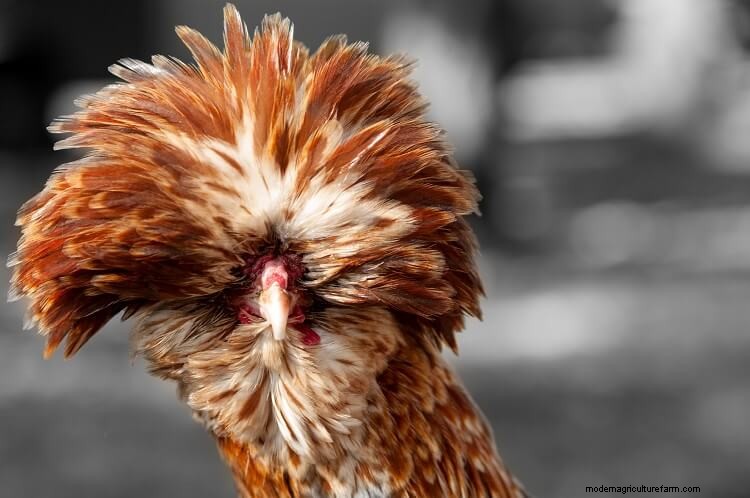
The Polish has an unmistakable appearance – the girls have pom pom hairdos and the boys look like bad hair days!
You may have heard this breed referred to as a Tophat or Paduan.
They are gentle, quiet, friendly and are well suited for children. They are mainly used for ornamental or show purposes these days, but they do lay fairly well. Hens can lay 3-4 large eggs each week.
Just remember that their head feathers can cause problems as they impinge upon the eyesight, so these chickens should be confined or supervised in free ranging.
| Polish |
|---|
| Main Use: Pet |
| Yearly Egg Production: 100-170 |
| Egg Color: White |
| Beginner Friendly: Yes |
| Temperament: Friendly |
| Noise Level: Normal |
| Preferred Climate: Any |
Silkie
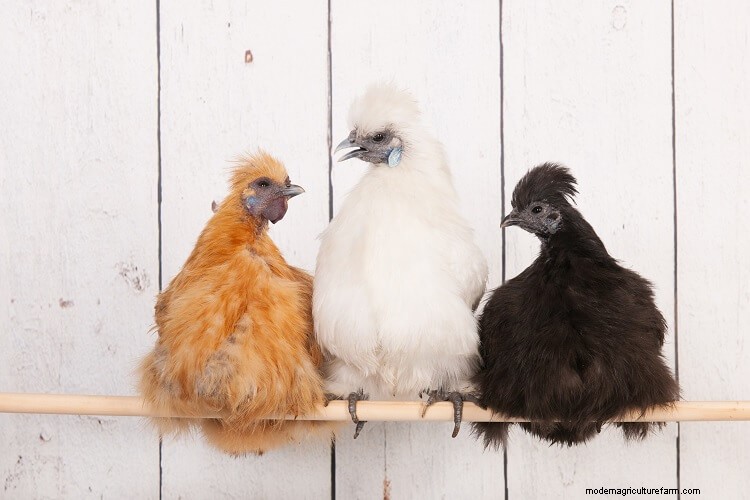
The Silkie is a much loved breed all over the world. Originating in China, this breed has become one of the most popular chickens of all time.
They are best known for their furry rather than feathered look. Kids just love to touch them as they also feel furry.
This breed makes for great pets since they love to cuddle, quiet and are very friendly. The hens are frequently used as broodies since they love to sit on eggs and they make very attentive mothers.
Since they cannot fly they are best confined or if left to free range they must be supervised.
Silkies come in a variety of colors and some have beards.
| Silkie |
|---|
| Main Use: Pet |
| Yearly Egg Production: 100-170 |
| Egg Color: Cream |
| Beginner Friendly: Yes |
| Temperament: Friendly |
| Noise Level: Quiet |
| Preferred Climate: Any |
Meat
Bresse
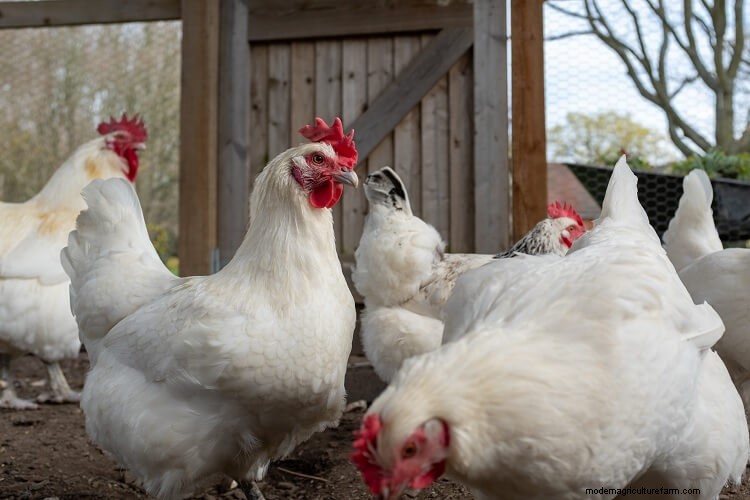
The Breese chicken originated in France and is the premier meat chicken in the world.
Raising this hen is very strictly controlled and only farmers that conform to the specifications are allowed to sell their chickens as Bresse.
The American Bresse has been around for a few years now. It is the same breed but cannot be called a Bresse as it would violate trade standards.
This chicken breed is primarily a meat breed however hens do lay a moderate amount of cream colored eggs each year.
There are some color variations, but the most well-known color is white. They can be flighty and aloof with people.
| Bresse |
|---|
| Main Use: Meat |
| Yearly Egg Production: 100-170 |
| Egg Color: Cream |
| Beginner Friendly: No |
| Temperament: Friendly |
| Noise Level: Normal |
| Preferred Climate: Any |
Cornish Cross
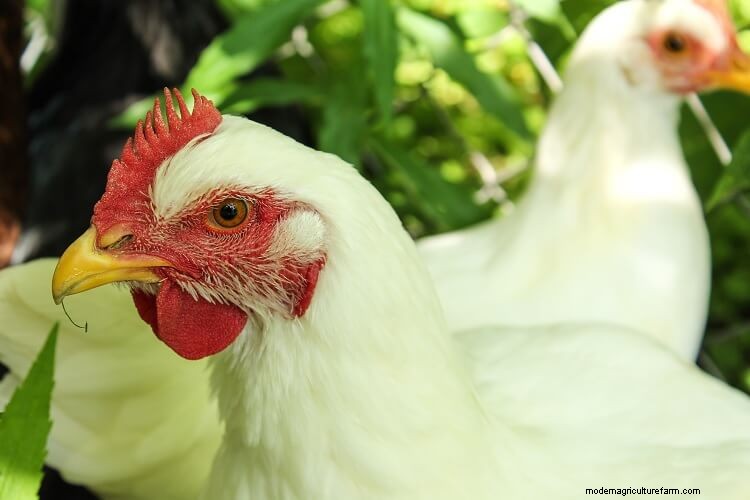
The Cornish Cross broiler was created by the poultry industry over 50 years ago and still dominates the meat market today.
This chicken is a cross between the commercial Cornish hen and a White Plymouth Rock.
Their growth rate is phenomenal so unfortunately they do not live much beyond six months.
Generally they are docile and calm. They do not forage but would rather hang out by the feeder. On the rare occasion that a hen lives to produce eggs, they will lay 2-3 small light brown eggs each week.
| Cornish Cross |
|---|
| Main Use: Meat |
| Yearly Egg Production: 100-170 |
| Egg Color: Brown |
| Beginner Friendly: No |
| Temperament: Docile |
| Noise Level: Quiet |
| Preferred Climate: Any |
Orloff
Although often nicknamed Russians, this breed actually came from Persia.
However they gained popularity in the early 1800s by a Russian count named Orloff-Techesmensky.
They are more of a meat bird since the eggs are small and few in number.
As you might expect, they are well suited to cold climates and are found in several color varieties.
They are a calm and quiet chicken but not overly friendly or docile.
In the US they are rare and do not have a place in the American Poultry Association. Worldwide they are in need of conservation.
| Orloff |
|---|
| Main Use: Meat |
| Yearly Egg Production: 100-170 |
| Egg Color: Brown |
| Beginner Friendly: No |
| Temperament: Docile |
| Noise Level: Quiet |
| Preferred Climate: Cold Hardy |
Bantams
Barbu d’Uccle

Meet the first true bantam in this guide.
She originates from Belgium and is a popular choice for those without much space.
The Barbu D’Uccle is a delightfully friendly little hen that enjoys being held. She will frequently perch on your shoulder and talk to you – needless to say she is a perfect chicken for kids.
They come in a variety of colors with mille fleur being the most desirable. They have beards, muffs, vulture hocks and feathered feet, so an all round profusion of feathers!
The hens have a mixed reputation as layers. I have found them to lay (small cream eggs) fairly consistently through the warmer months shutting down for winter.
| Barbu d’Uccle |
|---|
| Main Use: Bantam |
| Yearly Egg Production: 175-250 |
| Egg Color: Cream |
| Beginner Friendly: Yes |
| Temperament: Friendly |
| Noise Level: Normal |
| Preferred Climate: Any |
Booted Bantam
These little chickens are true bantams.
They are known as Sablepoot in the UK and can be traced back to the sixteenth century.
They look similar to the Barbu d’Uccle with feathered feet and vulture hocks.
These hens are very friendly and calm and do well with children. They are good foragers, but really should be kept in a covered area for their own safety.
Hens weigh around 27oz and are good summer layers giving you 3 small white eggs each week.
| Booted Bantam |
|---|
| Main Use: Bantam |
| Yearly Egg Production: 100-170 |
| Egg Color: White |
| Beginner Friendly: Yes |
| Temperament: Friendly |
| Noise Level: Normal |
| Preferred Climate: Any |
Dutch Bantam
Despite their name the Dutch bantam did not originate in Holland.
They are a true bantam and have no large counterpart.
Hens weigh a slight 14oz and there is plenty of variety with over 25 color variations.
The ladies are fair to moderate layers of small white eggs. They also make great broodies and are wonderful mothers.
When raised from chicks they can be very tame and friendly with a good temperament.
The breed is not particularly winter hardy, nor do they enjoy too much heat. They should have plenty of room as they are active and like to fly.
| Dutch Bantam |
|---|
| Main Use: Bantam |
| Yearly Egg Production: 100-170 |
| Egg Color: White |
| Beginner Friendly: Yes |
| Temperament: Docile |
| Noise Level: Normal |
| Preferred Climate: Any |
Nankin
The Nankin is probably the oldest true bantam.
Records go back to the 1500s but the Nankin was known long before then.
This is a tiny breed weighing only 22-24oz and is unfortunately critically endangered worldwide.
She is a talkative, curious and social bird that likes to be active. They can be found with either a single or rose comb (better for cold climates). These little hens always range together as a flock to improve their chances of survival.
The hens will lay small cream eggs and are exceptional sitters, so much so that they are frequently used on English game farms to raise partridges.
| Nankin |
|---|
| Main Use: Bantam |
| Yearly Egg Production: 100-170 |
| Egg Color: Cream |
| Beginner Friendly: Yes |
| Temperament: Friendly |
| Noise Level: Normal |
| Preferred Climate: Any |
Pekin Bantam
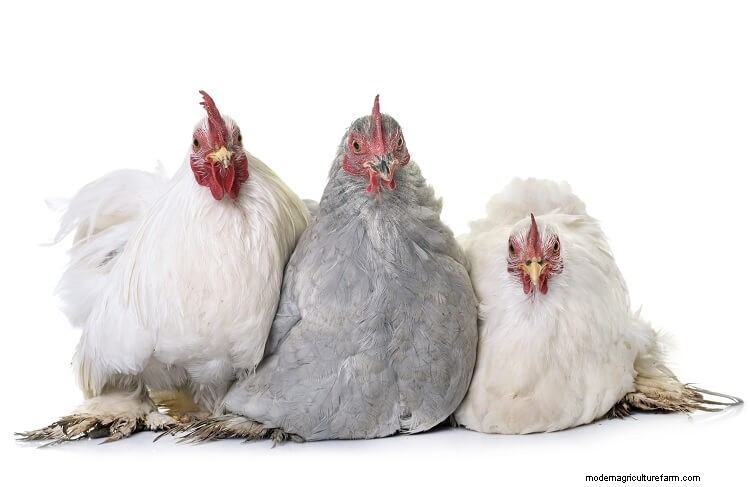
The Pekin bantam is a British breed that is known elsewhere as a Cochin bantam. As their name suggests, they are a true bantam and there is no standard counterpart.
They are well feathered, but despite all that feathering they really do not tolerate winters too well.
This bantam breed is gentle and docile but will only lay 2 small white eggs a week.
There are several color varieties to choose from and can become great pets (especially for children).
| Pekin Bantam |
|---|
| Main Use: Bantam |
| Yearly Egg Production: <100 |
| Egg Color: White |
| Beginner Friendly: Yes |
| Temperament: Friendly |
| Noise Level: Normal |
| Preferred Climate: Any |
Sebright
The Sebright is a very distinctive chicken which was developed in the 1800s in England.
They are a true bantam and the oldest English bantam.
Interestingly the roosters are hen feathered which means there is no plumage difference in the sexes. The chicken has a rose comb and stunning plumage – there are two color varieties (gold and silver).
The hen will weigh in around 20oz and is a poor layer.
Unfortunately there is a high mortality rate for chicks in this breed making them difficult to raise – so not a hen for a novice.
These little birds are friendly, active and very social. Roosters are not known for aggression at all.
| Sebright |
|---|
| Main Use: Bantam |
| Yearly Egg Production: <100 |
| Egg Color: White |
| Beginner Friendly: No |
| Temperament: Friendly |
| Noise Level: Normal |
| Preferred Climate: Any |
Serama
The Serama owns the title of the smallest chicken in the world . These tiny chickens are generally under 500gm (17oz) but there are some that are only half this size.
Although they are small in stature they have a big personality.
This breed is friendly, gentle, loves human company and is quiet. They should be kept in confinement for their safety.
The Serama hen will lay 3-4 small eggs each week and likes to be broody.
| Serama |
|---|
| Main Use: Bantam |
| Yearly Egg Production: 100-170 |
| Egg Color: Cream |
| Beginner Friendly: No |
| Temperament: Friendly |
| Noise Level: Normal |
| Preferred Climate: Warm Climates |
Exhibition And Show
Ayam Cemani
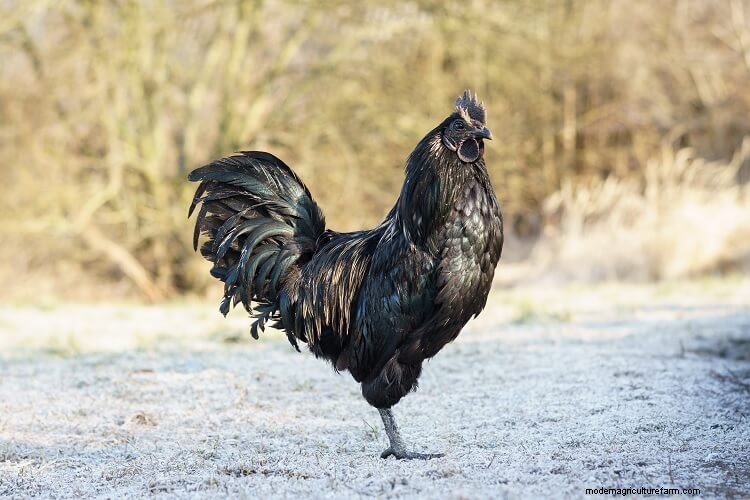
This all black melanistic chicken originated in the Indonesian Islands.
The melanoma means that everything is black:muscles, organs, heart and even the tongue!
Because they are black they are highly revered in their homeland where they are considered to have magical properties.
They are standard sized hens and weigh around 3.5-4.5lb.
The hens are cyclic egg layers which means they go through a cycle of laying eggs then stop for a while before resuming.
Because of this they are considered poor layers since they only put out around 80 cream colored eggs a year.
| Ayam Cemani |
|---|
| Main Use: Exhibition |
| Yearly Egg Production: <100 |
| Egg Color: Cream |
| Beginner Friendly: No |
| Temperament: Friendly |
| Noise Level: Normal |
| Preferred Climate: Warm Climates |
Brabanter
The Brabanter is another old and distinguished breed.
Their name comes from the Brabant area which covers part of Belgium and Holland.
There are both standard and bantam sizes available, but both are rare these days.
A standard hen weighs between 5-6lb and will lay white eggs in moderate amounts.
She is a shy chicken, but can be friendly. Roosters are highly strung.
| Brabanter |
|---|
| Main Use: Exhibition |
| Yearly Egg Production: 100-170 |
| Egg Color: White |
| Beginner Friendly: Yes |
| Temperament: Docile |
| Noise Level: Normal |
| Preferred Climate: Any |
Crevecoeur
The Crevecoeur is an ancient French breed that is now critically endangered.
It was originally a dual purpose breed and can still be used as such, but today it is mainly an ornamental breed.
They have an all black plumage with a head crest that almost hides the rooster V shaped comb. They are a medium sized standard chicken with hens weighing around 6.5lb.
Hens are moderate layers of medium sized white eggs (roughly 3 each week).
Their personality is calm, docile and active. They do tolerate confinement fairly well, but enjoy free ranging too.
| Crevecoeur |
|---|
| Main Use: Exhibition |
| Yearly Egg Production: 100-170 |
| Egg Color: White |
| Beginner Friendly: Yes |
| Temperament: Docile |
| Noise Level: Quiet |
| Preferred Climate: Any |
Cubalaya
The Cubalaya was developed in Cuba from Filipino poultry.
It has a pea comb and a very distinctive lobster tail.
They were used for cock fighting in their homeland as roosters are known for being aggressive. However towards people, the Cubalaya is friendly, curious and remarkably tame.
In the US this breed is thought of as an ornamental breed.
As you would expect they tolerate high heat and humidity well but do not do well in cold climates.
The Cubalaya is not a large hen at only around 4lb.
| Cubalaya |
|---|
| Main Use: Exhibition |
| Yearly Egg Production: 175-250 |
| Egg Color: Cream |
| Beginner Friendly: Yes |
| Temperament: Friendly |
| Noise Level: Loud |
| Preferred Climate: Warm Climates |
Egyptian Fayoumi
This particular breed is thought to have been in existence for around 3000 years! It comes from south western Egypt where it has thrived in the hot climate.
They are tough, independent, noisy and can fly very well.
As you may imagine they do not do well in confinement, it makes them more nervous and they start to feather pick each other.
If raised from chicks you can get them to be accepting of you, but they are not a very social breed where humans are concerned.
The Fayoumi is a small chicken that will only weigh 3.5lb.
They will lay 3 small tinted eggs per week and are not known for being broody.
| Egyptian Fayoumi |
|---|
| Main Use: Exhibition |
| Yearly Egg Production: 100-170 |
| Egg Color: White |
| Beginner Friendly: No |
| Temperament: Quarrelsome (Aggressive) |
| Noise Level: Loud |
| Preferred Climate: Warm Climates |
Houdan
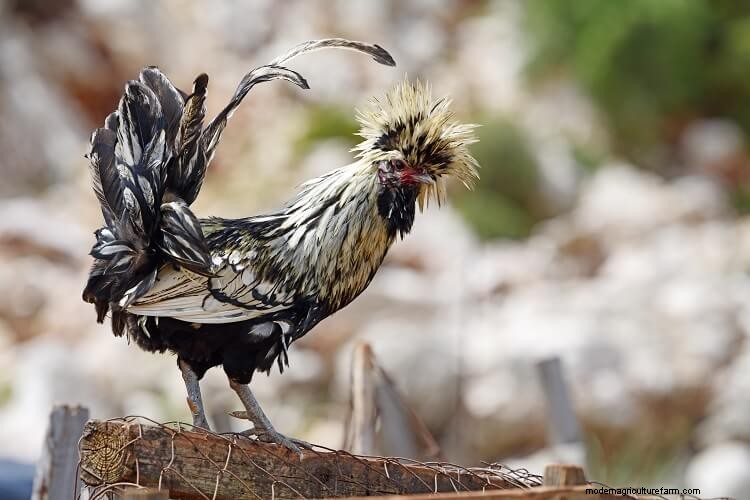
The Houdan is a very old breed that came from France.
They are considered unusual because they have a crest, beard and five toes. Their comb is also unusual as it is a V shape. They were once widely kept as dual purpose hens, but nowadays are more ornamental or exhibition birds.
Do not expect many eggs with this breed as they will only give 2-3 small eggs a week. They are non-setters, but older hens can have a tendency towards broodiness.
Overall this is a docile and sweet chicken that enjoys lap time and is good with kids.
| Houdan |
|---|
| Main Use: Exhibition |
| Yearly Egg Production: 100-170 |
| Egg Color: White |
| Beginner Friendly: Yes |
| Temperament: Docile |
| Noise Level: Quiet |
| Preferred Climate: Any |
Malay
The Malay chicken is certainly not for everyone.
This is an unruly chicken prone to picking on other breeds – they will even feather pluck their own if confined.
They are a game bird (hence the crabby temperament) and were widely used back in the 1900s to create or invigorate other breeds.
These days the Malay is considered to be an ornamental or show bird. The hens are poor layers, so if you get one egg a week you will be lucky.
As they originate from Indonesian they are tolerant of heat, not so much the cold though!
| Malay |
|---|
| Main Use: Exhibition |
| Yearly Egg Production: <100 |
| Egg Color: Brown |
| Beginner Friendly: No |
| Temperament: Quarrelsome (Aggressive) |
| Noise Level: Normal |
| Preferred Climate: Warm Climates |
Old English Game
The Old English Game has remained virtually unchanged for 2000 years!
Unfortunately it was introduced to Britain by the Romans for cock fighting. However since cock fighting is now illegal, it is used as a show or exhibition bird.
This breed cannot be kept with other fowl as it will fight them – even the hens will fight.
Roosters should be separated out at six months or they will fight to the death.
Surprisingly though, they can be friendly and talkative with their humans.
| Old English Game |
|---|
| Main Use: Exhibition |
| Yearly Egg Production: 100-170 |
| Egg Color: Cream |
| Beginner Friendly: No |
| Temperament: Quarrelsome (Aggressive) |
| Noise Level: Loud |
| Preferred Climate: Any |
Onagadori
This breed is for those who have the time, energy and devotion to care for them.
The Onagadori is an ancient breed from Japan where it enjoys a special historical status.
They are friendly, calm, docile and are primarily used for shows.
Onagadori literally means long tail in Japanese, and they are kept for these tails. The longest tail ever recorded was a stunning 88 feet.
These chickens need special accommodations and care and should be kept by themselves to prevent damage to their tails.
| Onagadori |
|---|
| Main Use: Exhibition |
| Yearly Egg Production: 100-170 |
| Egg Color: White |
| Beginner Friendly: No |
| Temperament: Docile |
| Noise Level: Quiet |
| Preferred Climate: Warm Climates |
Phoenix
The Phoenix is a German creation that came into being around the 1800s.
They are a cross between several Japanese long tailed breeds and several German breeds.
Interestingly the Phoenix molts their tail each year.
It is a beautiful breed with a good personality – they are alert, docile, gentle and talkative. They are known to be friendly and can become good pets.
Today they are mainly used as show breeds and there are several color varieties to choose from.
| Phoenix |
|---|
| Main Use: Exhibition |
| Yearly Egg Production: <100 |
| Egg Color: Cream |
| Beginner Friendly: No |
| Temperament: Friendly |
| Noise Level: Normal |
| Preferred Climate: Any |
Red Jungle Fowl
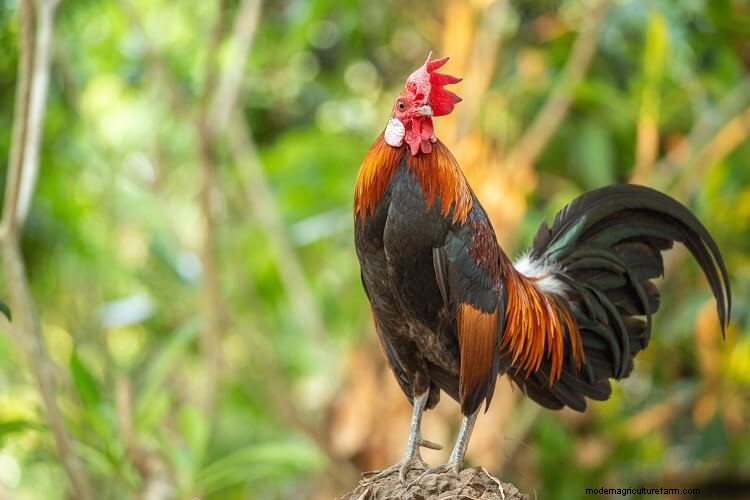
Meet the breed that started it all.
The Red Jungle fowl is an ancestor of pretty much every chicken we see today.
They were captured and semi-domesticated around 8000 years ago by humans. They still roam freely in areas of the Far East from Thailand down to the Indonesian islands. To this day they remain wary of humans and avoid contact if possible.
This breed does not like being handled and if allowed to free range will wander far and wide.
The Jungle fowl is a smallish chicken with hens reaching only 2¼lb.
| Red Jungle Fowl |
|---|
| Main Use: Exhibition |
| Yearly Egg Production: <100 |
| Egg Color: White |
| Beginner Friendly: No |
| Temperament: Bold (Self Assured) |
| Noise Level: Normal |
| Preferred Climate: Warm Climates |
Shamo
The Shamo is an Asian breed and was originally raised as a fighting bird. They are a tall chicken with muscular thighs and body, a small pea comb and very small or non-existent wattles.
This chicken is actually a strain of the Asian Asil (Aseel). There are four varieties of Shamo with the heaviest rooster weighing around 12lb.
A chicken like this requires special handling and accommodations.
Even the hens can be aggressive with other breeds and roosters will fight and kill other chickens. This aggressive trait can also be problematic with the chicks – they may fight and kill each other.
Hens are poor layers giving you perhaps 2 light brown medium sized eggs per week.
These birds are not for novices and definitely not children.
| Shamo |
|---|
| Main Use: Exhibition |
| Yearly Egg Production: <100 |
| Egg Color: Brown |
| Beginner Friendly: No |
| Temperament: Quarrelsome (Aggressive) |
| Noise Level: Normal |
| Preferred Climate: Warm Climates |
Sultan
The Sultan is the ultimate in show chickens .
This chicken has it all:V comb, crest, beard and muffs, vulture hocks, feathered feet, a long tail and five toes.
Originally they are from Turkey where they were known as the Serai Taook or Sultans fowl. They were allowed to roam the grounds of the palace because they did not scratch up the dirt or grass.
They are a calm, docile and very friendly hen well suited to pet status. They like to be active but should be either confined or supervised whilst free ranging.
Unfortunately they are critically endangered according to the Livestock Conservancy.
| Sultan |
|---|
| Main Use: Exhibition |
| Yearly Egg Production: <100 |
| Egg Color: White |
| Beginner Friendly: No |
| Temperament: Docile |
| Noise Level: Quiet |
| Preferred Climate: Warm Climates |
Sumatra
The Sumatra was originally imported from Indonesia where it can still be found today.
They were originally used as a fighting bird and although the males can be aggressive during the mating season, it is rare to find them fighting to the death. Out of mating season they are relatively calm.
This is not a breed that tolerates confinement. They are active, restless and fly well. They can be easily handled by their humans.
The hens weigh around 4lb and are variable layers (strain dependant).
Their main use today is as an ornamental breed and they can be found in bantam size also.
| Sumatra |
|---|
| Main Use: Exhibition |
| Yearly Egg Production: <100 |
| Egg Color: White |
| Beginner Friendly: No |
| Temperament: Skittish |
| Noise Level: Normal |
| Preferred Climate: Any |
Thuringian
The Thuringian comes from the Thuringian Forest area of Germany and has been documented since the mid-1700s.
This is a rare chicken although their popularity seems to be increasing.
They are considered to be a dual purpose breed but now they are mainly kept for eggs and exhibition. Hens will lay 3 white eggs each week and rarely go broody – if they do, they make good mothers.
There are several color varieties to choose from and they are all bearded with muffs.
Overall this is a confident, active, talkative and very friendly chicken that would be ideal for children.
| Thuringian |
|---|
| Main Use: Exhibition |
| Yearly Egg Production: 100-170 |
| Egg Color: White |
| Beginner Friendly: No |
| Temperament: Bold (Self Assured) |
| Noise Level: Normal |
| Preferred Climate: Any |
Tomaru
This ancient breed can be traced back about 1500 years!
The breed we see today was developed in Japan and is considered an historical artifact in Japan.
They belong to the long crowing family and roosters can hold their crow for up to 25 seconds.
Boys also have long tails that can grow up to 4 feet, so special accommodations are required for this breed.
Hens are poor layers producing 2 white eggs each week.
Personality wise they are known for being gentle and talkative. Their plumage is all black with a green sheen in the light.
Tomarus are kept mainly for exhibition in the west, but in the Far East there are crowing contests for which these chickens are kept.
| Tomaru |
|---|
| Main Use: Exhibition |
| Yearly Egg Production: <100 |
| Egg Color: White |
| Beginner Friendly: No |
| Temperament: Docile |
| Noise Level: Loud |
| Preferred Climate: Warm Climates |
White Faced Black Spanish
The White Faced Black Spanish, also known as Cara Blanca, hails from Spain and is an old breed possibly dating back to the 1500s.
Sadly these days she is critically endangered.
This breed is mainly kept for eggs and ornamental purposes. They certainly stand out from the crowd with their white clown faces . The hens are decent layers, producing 3 large white eggs a week.
They are independent and do not like to be picked up or held. You can expect a noisy flighty chicken that likes to free range and forage.
This breed is rather slow to mature and can take a year to reach adulthood.
White Faced Black Spanish are available in standard or bantam size.
| White Faced Black Spanish |
|---|
| Main Use: Exhibition |
| Yearly Egg Production: 100-170 |
| Egg Color: White |
| Beginner Friendly: No |
| Temperament: Skittish |
| Noise Level: Loud |
| Preferred Climate: Warm Climates |
Yokohama
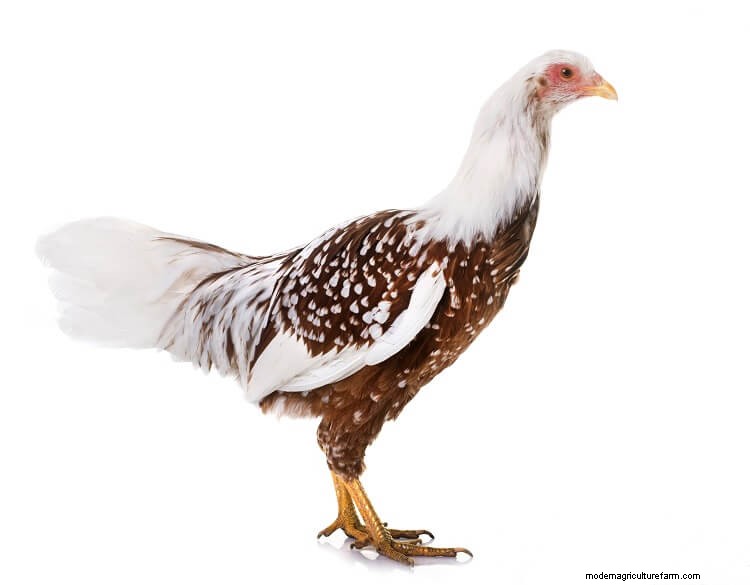
Despite the name, the Yokohama was created in Germany from Japanese parents back in the 1880s. Today it is critically endangered and in need of support.
It is bred for exhibition, show and ornamental uses only.
This is a small breed that is bred for their incredibly long tails (they can grow up to 3 feet each year).
They love to free range as they are an active bird that is always alert for danger.
Overall they are a low maintenance bird that is easy to handle and can become docile and friendly in time.
| Yokohama |
|---|
| Main Use: Exhibition |
| Yearly Egg Production: <100 |
| Egg Color: Cream |
| Beginner Friendly: Yes |
| Temperament: Docile |
| Noise Level: Quiet |
| Preferred Climate: Any |
5 Tips For Picking The Perfect Breed
- The first rule of chicken keeping is to do your homework. Only you know what kind of hen you want so research them thoroughly. If you are looking for a chicken that is friendly, docile and calm make sure you do not pick a breed that is known for fighting! Words like shy, aloof and independent all give you clues that this is not a pet chicken. Words like flighty or active are code that you may have them roosting in trees. If you are looking for chickens for your kids to raise for 4H projects, be aware that some hatcheries carry lines that are not acceptable for 4H (read the small print).
- Do you have the time and patience to care for a flock during summer and winter? They are not demanding but they do have certain needs. Some breeds need special considerations and extra care. Make sure you pick a breed that matches your expectations. Some breeds can be low maintenance whilst others can be demanding.
- It can be expensive to start raising chickens (coop, secure run, feeders etc.). If you are on a budget then consider the price of your breed carefully as certain breeds can run over $100 per hen.
- If you are a beginner and want to buy from a local source (independent breeder or neighborhood farm) make sure to check them out first. Check out the conditions in which the chickens are kept – if it is filthy then walk away as you do not want chickens that are likely diseased or ill. Ideally you should try to take someone experienced with you so they can help. There are some unscrupulous breeders out there so buyer beware!
- Lastly make sure to check that chickens are allowed where you live. Some towns prohibit poultry and some just prohibit roosters. Ignorance of bylaws and regulations is no defence and you may have to part with your chickens. It is always a good idea to see how close neighbors would feel about having chickens next to their house even if there are no prohibitions.
Resumen
Chickens are one of the easiest livestock animals to care for and fit well into a small space if need be.
We hope you have enjoyed looking through our chicken breed list.
Hopefully it has helped you to decide what you want in your coop.
Our aim was to let you know what is available and what sort of chickens there are so that you do not end up with a hen that is of no practical use to you.
Did we miss your favorite breed? Let us know in the comments section below…



































